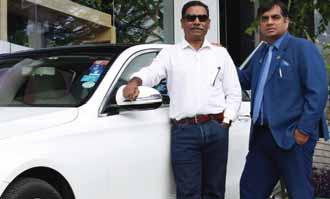





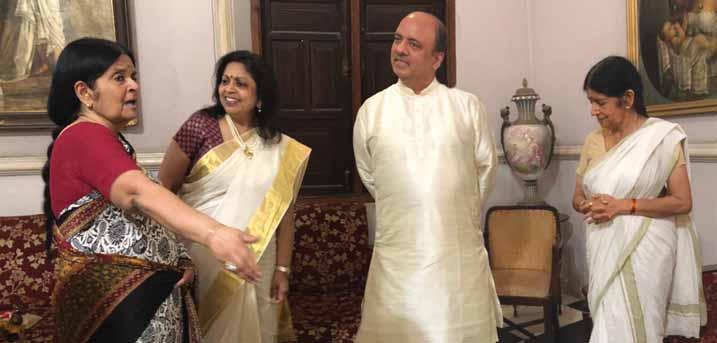
12 Suicide is a cry for help
It is time we address this silent killer on a war footing.
22 Group dynamics work best in Rotary: Shekhar Mehta
A multi-district felicitation for RIPN Shekhar Mehta.
28 World leaders pledge $2.6 billion for polio’s Last Mile
At Abu Dhabi, world leaders renew their pledge to eradicate polio.
32 Smuggling immigrants in containers to UK: Flashback to 25 years ago
Two journalists posed as asylumseekers to interview illegal migrants and their brokers.
50 100 years of doing good in Kolkata
Members of RC Calcutta walk down memory lane as the club celebrates its centenary.
60 Starting a dialogue on menstruation
A multi-district seminar trains teachers to educate girls on better menstrual health management.
22


12

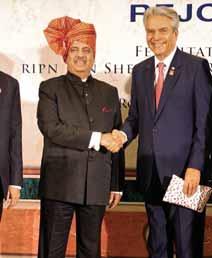



64 A Rotaract club sustains an annual event for 19th year
Rotaractors have been consistently providing a platform for differently-abled children to exhibit their talent.


60

28 On the cover: Searching for love and solace. Picture by Gabriel Isak.
50



64

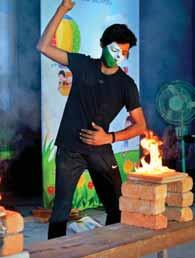





The cover story on RIPN Shekhar Mehta made excellent reading. Also, the cover photo and other pages are very impressive. Your editorial rightly highlights the grave problem faced by disabled persons in our society.
In all, the November issue has excellent reading material. Congratulations for raising the standard of Rotary News with excellent teamwork under your editorship.
R K Bubna
RC Belur — RID 3291
Iam happy to note that Rotary New s has transformed a great deal with interesting content to read, a better layout and design in recent years. The Nov issue has articles that throw light on Rotary’s areas of focus and its objective of reaching out to the community with great service projects. The concept that the current RI President should not be in Evanston, the RI headquarters,
The Editor’s Note captioned Undaunted by their disability in the Nov issue is apt, for nothing can stop those who want to achieve big. Hats off to wonder women Kuhu Das, and Jeeja Ghosh, who are fighting for the rights of the disabled.
RI Directors Dr Bharat Pandya and Kamal Sanghvi have laid emphasis on TRF contributions, which will help the poor and needy.
A good formula of giving is that if you have to choose between being kind or right, choose the former to be always right. Help people to overcome their fears without condescension. It
when the selection committee meets to select RI’s new leader is noteworthy. The elaborate interview of RIPN Shekhar Mehta, his views and plans for Rotary, only point to his qualities as a great Rotary leader. Trustee Chair Gary Huang’s message, the article Lifestyle Medicine and other articles are interesting to read and enjoy.

R Thayumanavan RC Cuddalore Midtown — RID 2981
to Rotary News for publishing some innovative projects taken up by Rotary clubs, an eye-opener for Rotarians. One is the Dinner in the Dark project of RC Chandigarh Shivalik, RID 3080, which aims to sensitise Rotarians and the larger community about the difficulties faced by the visuallyimpaired. Hats off to the club.
will make them and you happier than you imagine. We should contribute to TRF to the best of our capacity as it will help in a big way to fight hunger, provide healthcare and literacy.
Raj Kumar Kapoor RC Roopnagar — RID 3080
RCBareilly South, RID 3110, has set a good example of utilising the CSR fund through its project addressing open defecation in villages.
Rotary is a good platform for CSR activity. This model project shows the best way to utilise the CSR funds from the corporates. Congrats to the club
We conducted a similar programme at a local college recently. It was a different type of concert presented by pianist Anil Srinivasan and his orchestra; the audience was seated in a packed auditorium in utter darkness for an hour to feel the world of visuallychallenged people, experiencing classical songs. The project raised funds for a home in Chennai for 60 visually-impaired girl inmates. It made us think about the lives of those in darkness. Many of our clubs can implement such projects to help the less-privileged people.
R Srinivasan, RC Madurai Midtown — RID 3000
Weare inspired by the cover story of our leader RIPN Shekhar Mehta (Nov’19) as it details his journey in Rotary and
leaders and the managing director of B L Agro Oils for executing a needbased project for society.
Chinmaya Mahapatra
RC Bhubaneswar
Heritage — RID 3262
Thearticle Let’s make India literate by 2025 is interesting. It will be really a gift of Rotary to the nation if we could accomplish this grand mission. For, literacy is the means to achieve various goals in society. I congratulate RIPN Shekhar Mehta for his tireless efforts.
Dr Prosenjit Ghosh, RC Green Land Silchar — RID 3240
his future plans. His vision is clear — he wants Rotarians to think and act big. We agree that Rotary should get a Noble Prize. Thanks a lot for the nicely-packaged issue.
Swathi Singh and Ranjit Singh Thakur, RC Gems Nizamabad — RID 3150
congratulations to PRID Shekhar Mehta for getting selected as RI President (2021–22). Special appreciation to Rasheeda Bhagat for the excellent cover photo, a well-written editorial titled Undaunted by their disability and the Trustee Chair inspecting service projects in RID 3201. Keep it up.
Daniel Chittilappilly RC Kalloor — RID 3201
Ihavecome across two extraordinary people who are good leaders and dream
RIExcellent editorial
President Mark Maloney asks us to raise funds for polio, and says that its eliminaion will get Rotary global acclaim. We share the same feelings of Editor Rasheeda Bhagat over the importance of education. She has rightly pointed out that there are millions of children for whom even basic literacy remains just a dream, beyond their reach.
With our literacy rate at only 74 per cent, it is debatable if we are providing quality education to our children. As an 85-year-old citizen, I have spent 20 years of my life as
big. One, our PM Narendra Modi, two our RIPN Shekhar Mehta.
November issue is really a collector’s item. The coverage of RIPN is amazing, focusing on his thoughts, work, career, challenges, beliefs and ideas. Mehta has rightly said India is the Kohinoor in Rotary’s crown and his vision of getting Nobel Peace Prize for RI is really laudable.
A few weeks back, I met him at the Bhowanipur Jain temple. After the aarti he interacted with the local people, unrestrained by their caste or creed, following the Rotary ideology of not paying attention to one’s religion or region. If you are a Rotarian, you are welcome has been our credo as highlighted by Rasheeda Bhagat in her article.
Piyush Doshi RC Belur — RID 3291
a Rotarian and think the Oct issue editorial is the best one penned by the Editor so far.
The cover story on RC Mysore West’s pioneering work for children with hearing loss explains in detail the efforts of the club in reaching out to these special children over the last 30 years.
S Muniandi, RC Dindigul Fort — RID 3000
Ifully agree with the editorial that only education can usher in changes in various fields and make India the most powerful nation in the world. In this aspect, only Rotary can fulfill the aspirations
of the poor masses in India as Rotary leaders dream of total literacy by 2025.
I request RILM’s national committee to review TEACH and add innovative ways to quickly achieve visible results. The Literacy Summits are events with statistical analysis of our success stories, but in future these summits must give scope to our leaders to take decisions for realising total literacy in our country.
Arun Kumar Dash RC Baripada — RID 3262
Iwasimpressed with your thoughts on education in your editorial and how a common man is hungry for knowledge that can come only with education. Our first PM Jawaharlal Nehru set great emphasis on education and that is why he set up such quality educational institutions all over India. Today education is a business and nobody cares to do anything about this.
Fortunately, in Delhi, the right thrust has been given to education for all under the leadership of the Delhi Chief Minister Arvind Kejriwal. I suggest you do an in-depth interview with him and his deputy, Manish Sisodia, on their achievements so far and publish it in Rotary News
Robert Franklin Rego RC Bajpe — RID 3181
It was inadvertently reported in the article, Mehta’s dream, Nobel Prize (Nov’19) that PDG Vinay Kulkarni has contributed `50,000 to the Polio Fund. He has donated `500,000 for RILM. The error is regretted.
We welcome your feedback. Write to the Editor: rotarynews@rosaonline. org; rushbhagat@gmail.com Click on Rotary News Plus in our website www.rotarynewsonline.org to read about more Rotary projects.


There is no experience quite like attending the Rotary International Convention. Discover the true spirit of aloha and Rotary with your family, friends, and fellow Rotarians from June 6 to 10 in Honolulu. It is the perfect setting for the entire family of Rotary to celebrate, collaborate and connect.
There are two types of people who enjoy visits to Hawaii — those who have never been to the islands and are about to have unique and wonderful experiences, and those who have had those Hawaiian moments etched into their memories already and cannot wait to create some new ones.
The convention is the best place to find and share your aloha, which you will soon discover is much more than a greeting. Just as Rotary is a way of life for Rotarians, aloha is a way of life for Hawaiians — one that focuses on living in harmony, being patient, treating everyone with respect, and sharing joy with your family, or ‘ohana.
Our host committee has arranged some fabulous events for you and your family. These include a Hawaiian Culture and Lunch Boat Cruise, a two-hour tour that will feature spectacular views of Diamond Head, Waikiki, and the Kahala Gold Coast. On board, you can learn to play the ukulele, take part in hula dancing, and create your own Hawaiian flower lei.
You will also have the opportunity to enjoy a full range of island hospitality events, from small backyard picnics to multicourse family meals. There will be
fantastic service projects to see, including two ancient Hawaiian fishponds. And a sunrise Walk for Peace will take place at the beautiful Ala Moana Beach Park, a 3-mile-stroll in the shadow of the iconic Diamond Head crater.
Inside and outside the convention halls, we are going to hold the most family-friendly convention in Rotary history, including a family-centred opening ceremony and family-focused events in the House of Friendship. The opening session will, of course, include our traditional flag ceremony.
Our 2020 convention will also be a time to celebrate Rotary’s historical ties to the United Nations. As I mentioned in my November message, June 2020 will mark the 75th anniversary of the signing of the United Nations charter. On the day before the start of the convention, Rotary and the UN will host our fifth joint event of 2019–20, one focused on environmental sustainability.
In addition, we are planning the greenest convention in Rotary history — and I will share more details about this in the months ahead. But now, go to riconvention.org and click the register button right below the Honolulu Hawaii 2020 logo. Early registration discount pricing ends Dec 15, so do not delay.
Rotary Connects the World in no better way than at the Rotary Convention. Bring your family to meet our family. See you in Honolulu!
Mark Daniel Maloney President, Rotary International

eading and rereading classics is a constant source of joy for me. It amazes me that every couple of years when I revisit my favourites such as Thomas Hardy’s The Mayor of Casterbridge, or Jane Austen’s Pride and Prejudice; George Eliot’s The Mill on the Floss; Harper Lee’s To Kill a Mocking Bird; Khaled Hosseini’s The Kite Runner and of course that delightful and unputdownable novel by Emily Bronte, Wuthering Heights, the narrative unpeels for me a fresh layer of perspective, wonder, awe and admiration. These days I am into reading the brilliant prose penned by black female writers… Chimamanda Ngozi Adichie’s searing and award-winning Half of a Yellow Sun; Alice Walker’s classic The Color Purple and the Nobel Laureate Toni Morrison’s unforgettable classic The Bluest Eye, about which a review in The New York Times had said: “so charged with pain and wonder that the novel becomes poetry”. In a recent edition of The Bluest Eye, (I must confess here my weakness for hoarding several editions of my most favourite books!) the author says that the title of her book has its genesis in a childhood friend in elementary school once confessing to her that she yearned for blue eyes. The very thought and visual of a black girl with blue eyes “violently repelled” Morrison, and set her wondering why this girl was not happy with what she had and wished such a radical alteration in her external appearance which would actually make her grotesque.
Morrison’s reference to “racial beauty” and the American standards of seeing beauty only through a white prism… fair skin and blue eyes… much more strongly in the 1900s than now, gives us so much food for thought. Because in so many parts of India,
even today, a woman’s beauty is equated to a fair complexion. The plethora of “whiteness” creams that have sprung up in the Indian markets over the last few decades, and their patronage, also by men in recent times, is a testimony to the Indian craze for white skin. We just have to go through our matrimonial ads to reaffirm the Indian male, or his entire family, craving for a “fair bride”. And slim too. Not only feminists, but all sensible people, have protested against the kind of pressure such stereotypes put on generations of Indian girls, blessed with healthy and glossy brown skin, but who believe that they are somehow wanting in that questionable department of ‘beauty’. Slowly but surely this beauty myth places and then tightens its vice-like grip around their insecurity, resulting in their rejection of themselves, for something as silly and stupid as not being born with a fair skin! The loss of self-esteem that can follow in the minds and hearts of millions of such women can have horrific consequences and leave them all broken inside.
The cover story of this issue is on depression. Rejection of oneself because of external appearance, and that too based on misplaced and warped notions of beauty, can also, and I’m sure does, result in depression.
As women… mothers, wives, sisters, daughters, aunts, etc, let’s come together in our family lives to firmly and forcefully reject this ridiculous stereotype… that fair and slim is beautiful. Let’s reaffirm and reiterate that while a brown/black skin can be stunningly beautiful, what makes a woman’s persona is not just her appearance, but her intelligence, her wit, the sparkle in her eye, the kindness in her heart… and a hundred other qualities which make a woman so special!
Rasheeda Bhagat
RI Dist 2981
RI Dist 2982
DG N Manimaran
DG Natesan A K
RI Dist 3000 DG Dr A Zameer Pasha
RI Dist 3011 DG Suresh Bhasin
RI Dist 3012 DG Deepak Gupta
RI Dist 3020 DG M Veerabhadra Reddy
RI Dist 3030
DG Rajendra Madhukar Bhamre
RI Dist 3040 DG Dhiran Datta
RI Dist 3053
DG Harish Kumar Gaur
RI Dist 3054 DG Bina Ashish Desai
RI Dist 3060 DG Anish Shah
RI Dist 3070 DG Sunil Nagpal
RI Dist 3080 DG Jitendra Dhingra
RI Dist 3090 DG Rajeev Garg
RI Dist 3100 DG Hari Gupta
RI Dist 3110
DG Kishor Katru
RI Dist 3120 DG Sanjay Agrawal
RI Dist 3131 DG Ravee Dhotre
RI Dist 3132 DG Suhas Laxmanrao Vaidya
RI Dist 3141 DG Harjit Singh Talwar
RI Dist 3142
DG Dr Mohan Chandavarkar
RI Dist 3150 DG Pandi Sivannarayana Rao
RI Dist 3160 DG Nayan S Patil
RI Dist 3170
RI Dist 3181
RI Dist 3182
DG Dr Girish R Masurkar
DG Joseph Mathew
DG Ramesh B N
RI Dist 3190 DG Dr Sameer Hariani
RI Dist 3201 DG R Madhav Chandran
RI Dist 3202
RI Dist 3211
RI Dist 3212
RI Dist 3231
RI Dist 3232
RI Dist 3240
DG A Karthikeyan
DG Shirish Kesavan
DG S Sheik Saleem
DG Sridar Balaraman
DG G Chandramohan
DG Dr Debasish Das
RI Dist 3250 DG Gopal Khemka
RI Dist 3261
RI Dist 3262
RI Dist 3291
DG Ranjeet S Saini
DG Debasish Mishra
DG Ajay Agarwal
Printed by P T Prabhakar at Rasi Graphics Pvt Ltd, 40, Peters Road, Royapettah, Chennai - 600 014, India, and published by P T Prabhakar on behalf of Rotary News Trust from Dugar Towers, 3rd Flr, 34, Marshalls Road, Egmore, Chennai 600 008. Editor: Rasheeda Bhagat.
The views expressed by contributors are not necessarily those of the Editor orTrustees of Rotary News Trust (RNT) or Rotary International (RI). No liability can be accepted for any loss arising from editorial or advertisement content. Contributions – original content – are welcome but the Editor reserves the right to edit for clarity or length. Content canbereproduced,butwithpermissionfromRNT.

Goodhealth and good thinking are our most precious possessions, good health being the most important. Only if health is good, everything else follows. A sound body keeps not just the mind but all else sound. But we don’t pay attention to our health in our busy lives till we fall sick and then we run to doctors and hospitals. To add to this is the burden of lifestyle diseases, called NCD - Non-Communicable diseases. India is facing an NCD epidemic responsible for 60 per cent of deaths. Being Indian itself is a risk factor. More importantly, Indians are dying early and prematurely, with the big killer being bad food; rich in calories, high in salt, oil and sugar! An added factor is lack of exercise and a stressed lifestyle.
“An ounce of prevention is worth a pound of cure.” Let’s approach December — Disease Prevention and Treatment month — geared up to take forward our Rotary India initiative of Project Positive Health - Stop NCDs Project. A three-pronged approach is needed:
1. Early detection of NCDs - Know your numbers campaign.
2. Motivating life style changes - Ek Chammach Kum, Char Kadam Aage campaign.
3. Creating awareness of hazards of NCDs - Launch a social media campaign; create awareness in schools and colleges.
On Sep 29 (World Heart Day) and Nov 14 (World Diabetes Day), Rotarians all over India carried out hundreds of camps, held rallies, street plays, bicycle rallies and workshops reaching out to thousands of citizens by creating awareness and taking action. Well done to all the clubs and Rotarians who were involved in this activity. Well done to all National Committee Members. Their motivation, hard work and coordinated efforts made things happen.
On the treatment front, Rotary districts of Maharashtra signed an MoU with Fairfax India Charitable Foundation (FICF) for setting up dialysis centres by supplying dialysis machines. I firmly believe that the future of Rotary is partnerships which allow us to leverage our strengths and do more impactful, better work. The partnership with FICF is a good example. Rotary clubs can donate a machine for `4.15 lakhs (75 per cent of the cost, 25 per cent to be matched by FICF) which includes 4-years’ comprehensive maintenance. Starting as a pilot in Maharashtra, we expect it to roll out in other parts in the coming months. Let us all do our best working towards a healthier society by doing our work, our service with love and compassion as we ensure that Rotary Connects The World.

Dr Bharat Pandya RI Director, 2019–21

We believe good healthcare is everyone’s right. Yet 400 million people in the world can’t afford or don’t have access to basic healthcare.
Disease results in misery pain and poverty for millions of people worldwide. More than 100 million people are pushed into poverty each year because of high medical cost. That’s why treating and preventing disease is so important to us. By leading efforts, both large and small, Rotarians aim to improve and expand access to low-cost and free healthcare in underdeveloped areas of the world. We educate and mobilise communities to help prevent the spread of major diseases such as polio, HIV/AIDS and malaria. We set up temporary clinics, blood donation centres and training facilities in underserved communities struggling with outbreaks and healthcare access. We design and build infrastructure that allows doctors, patients and governments to work together.
Rotary’s top priority is the eradication of polio. Our members also take on far greater responsibilities to combat diseases like malaria, HIV/AIDS, kidney failure through dialysis services, congenital heart diseases, Alzheimer’s, multiple sclerosis, diabetes, etc.
Disease prevention and treatment take on many forms, from supporting studies to helping immunise people to improving the drinking water and sanitation infrastructure. The world relies on Rotary to tackle these global challenges, and to set an example for others to follow.
The old adage, Prevention is better than cure, still holds good. Understanding the import of this, RI Director Bharat Pandya and I have started a new initiative — Project Positive Health. Under this, we aim to stop NCDs by sensitising people to adopt the simple formula of Ek Chamach Kam, Char Kadam Aage, which translates to: One spoon less of sugar, salt and oil in your daily food and walk four steps more each day. We urge our Rotary clubs to conduct health check-up camps and educate the youth.
Remember health is wealth.

Board of Permanent Trustees & Executive Committee
PRIP Rajendra K Saboo RI Dist 3080
PRIP Kalyan Banerjee RI Dist 3060
RIPN Shekhar Mehta RI Dist 3291
PRID Panduranga Setty RI Dist 3190
PRID Sushil Gupta RI Dist 3011
PRID Ashok Mahajan RI Dist 3141
PRID Yash Pal Das RI Dist 3080
PRID P T Prabhakar RI Dist 3232
PRID Dr Manoj D Desai RI Dist 3060
PRID C Basker RI Dist 3000
TRF Trustee Gulam A Vahanvaty RI Dist 3141
RID Dr Bharat Pandya RI Dist 3141
RID Kamal Sanghvi RI Dist 3250
Executive Committee Members (2019–20)
DG Deepak Gupta RI Dist 3012
Chair – Governors Council
DG Nayan Patil RI Dist 3160
Secretary – Governors Council
DG Dhiran Datta RI Dist 3040
Secretary – Executive Committee
DG Ajay Agarwal RI Dist 3291
Treasurer – Executive Committee
DG Rajendra Madhukar Bhamre RI Dist 3030
Member – Advisory Committee
ROTARY NEWS / ROTARY SAMACHAR
Editor Rasheeda Bhagat
Senior Assistant Editor Jaishree Padmanabhan
ROTARY NEWS / ROTARY SAMACHAR
ROTARY NEWS TRUST 3rd Floor, Dugar Towers, 34 Marshalls Road, Egmore Chennai 600 008, India. Phone : 044 42145666 e-mail: rotarynews@rosaonline.org Website: www.rotarynewsonline.org
Now share articles from rotarynewsonline.org on WhatsApp.
NiveshGuru, a one-stop solution for all your investment needs.


The calm of a Sunday morning was destroyed by the shouting of an angry father next door, telling his 10-year-old daughter… “Just go and die. Jump down from the top of the building.” He does this often; my shock was compounded when the chubby child once told me quietly: “One day I’ll do just that.”
Next morning, a newspaper headline screamed: 19-year-old IIT-Madras student, depressed over low marks, commits suicide.
A 2015 WHO study found one in five Indians may suffer from depression in their lifetime; only 10–12 per cent seek medical help. After cardiac diseases and diabetes, suicide is the third cause of death in India.
“Suicide is the punctuation mark at the end of many artistic careers,” says Dr Lakshmi Vijayakumar, a suicide specialist with two honorary fellowships from the Royal College of Psychiatrists, London and Edinburgh.
The reasons vary from “inter-personal conflicts — with parents, friends or
peers — which cause a lot of distress in 15–29-year old youngsters. It could be academic issues or relationship stress. Perfectionism is one of the reasons that affects a person negatively with stress and bring the idea of suicide. In older people, it is mostly economic issues.”
Dr R Thara, Vice Chairman and Chair, SCARF, says a major cause for suicide is the inability to tolerate the intensity of depression. The hallmarks of depression are helplessness and hopelessness. “If they feel that they have no support, then people tend to gravitate to suicide. Often it is an impulsive reaction after failing in an exam, not getting a course the student wants, and even flimsy causes as the father not getting the child an iPhone or a high-end motorbike.” Today’s youth want instant gratification. They don’t have the patience to wait or understand the perspective of the parent, she adds.
Ruling out peer pressure, she says, “Rather it is their own pressure. Peers don’t tell them I have an iPhone, you too get one.
It is just that, he has an iPhone. So I too should own one.”
Domestic violence, excessive alcohol abuse can trigger suicide in the lower classes, especially where women are unable to bear the brunt and so, take their lives. Dowry deaths could be homicide or suicide.
Dr Lakshmi says that in India, more men than women commit suicide. But while older men (70 and above) end their lives, suicide is more common in the 18–29 age group in women. After 30, suicide rates come down by half.
The psychology
Parents’ lofty expectations, teachers’ hurtful admonishing, and a relationship gone sour, trigger suicidal thoughts in the young, particularly if their support system is weak. As most married women have a child by 30, that bonding sees them through problems. But later, when the children leave, they have to cope alone with health and finance.
Serials and cinemas also play a role in planting suicidal thoughts in young minds, says Dr Thara. “They think ending their life is easy as depicted in some movies. They know nothing of the pain in hanging or jumping from a rooftop or before a train, or burning themselves.”
Even cartoon movies can trigger suicidal thoughts in youngsters

Today’s youth want instant gratification. They don’t have the patience to wait or understand the perspective of the parent.
Dr R Thara Vice Chairman and Chair, SCARF
as children as young as 7 or 8 are exposed to dialogues like ‘I want to die’. Earlier children below 14 committing suicide was almost negligible. But of late children between 10–14 are known to commit suicide, says Dr Lakshmi.
Have you treated children of that age attempting suicide, I ask her. “Yes,” she answers gravely. “There was this brilliant child whose parents
were very supportive, and didn’t force him academically or otherwise. But everybody expected him to outperform; the child felt overwhelmed and panicked, thinking if he was not able to live up to their expectations, he’d be failing them.”
When he topped the class after an exam and the teacher said he’d surely get a State-rank, he became stressed and wrote a suicide note
saying, “I may be brilliant, but I am not sure if I will be able to meet all your expectations.” He hanged himself to death at the age of 10! Being in Scouts, he knew the exact knot to tie. It was his own fear of failure that result in the suicide here.
Another child who had typhoid, couldn’t prepare for her exam, was caught copying and as her parents were summoned the next day, that evening she climbed up the school building and fell to her death. Anything that brings shame or disgrace is a huge trigger for suicide in the young. They have still not developed a sense of identity or aren’t mature enough to handle stress. “Suicide in youngsters is a spontaneous reaction. Given a chance they wouldn’t even think about it,” she adds.
Dr Thara says that while in the West suicide is committed using guns or an overdose of drugs, in India,


Suicide in youngsters is a spontaneous reaction. Given a chance they wouldn’t even think about it.
Dr Lakshmi Vijayakumar

especially in Tamil Nadu, women take their lives by hanging or burning themselves; the last is unheard of in the West. The reasons are largely similar, except that there is a little more loneliness there. “Social isolation and less of social support is prevalent which is not much of a cause in India, but slowly spreading. We all live with families. If we do not take advantage of our social network, then it becomes a problem, paving way for depression.”
She says the Blue Whale challenge in India “was more a media hype. We did not see any case related to the game.”

A counsellor at IIT-Madras in the 1980s, Dr Thara throws light on why brilliant children who can enter an IIT, end their life so pathetically. Social and economic disparity, particularly for those who come from remote or rural areas, makes it difficult for such students to adjust to an “environment that is so different. English is spoken and they find it hard to adjust to the demands of the environment and the professional course they take. They probably have no idea


The Sneha Suicide Prevention Helpline, founded by Dr Lakshmi, is offering 24-hour on-call support, with a team of volunteers since 1986. One of the earliest helplines, it has been critical in suicide prevention in the city. The helpline was established after the psychiatrist came across the work of the Samaritans in the UK. They use volunteers to talk to people with suicidal inclinations. “When I went to Vienna to present a paper on suicide at an international conference, I was surprised to see the kind of work people have done on suicide prevention. This was 33 years ago; in our country we did not have any mechanism to stop suicide.”
The idea was met with lot of skepticism. “Chennai was still Madras and a very conservative community. People said nobody will come and talk to you that they want to commit suicide. Or, how can you run an organisation only with volunteers. I just went ahead and established Sneha in 1986.”
The helpline is open 365 days a year ever since except for the day the entire city was reeling under floods. The volunteers running the helpline even pay for their own transport. “When Rajiv Gandhi was assassinated, one of our volunteers, a 60-year-old man, cycled all the way from Perambur for two hours to reach office. That’s the kind of dedicated volunteers we have.” While earlier people used to drop
in at the office to discuss their problems, the facility moved on to telephone services. Now many youngsters prefer email. On an average Sneha gets about 60 calls a day, 80 per cent from people who are acutely suicidal or in the middle of the act: ‘I have taken four tablets and have another 10 in my hand. Or I am standing on top of my apartment building,’ those are the kind of calls we get nowadays,” says the doctor.
So how does she manage such situations? “The basic need for any human being is acceptance, irrespective of what he/she has done. A beggar came to Sneha and said, ‘please give me some money. I want to eat.’ One of our volunteers made him sit down and explained to him about our work. At the end of it, he stood up and said, “please don’t give me money ma. This is the first time somebody has made me sit on a chair and treated me like a human being.” That is total acceptance of the person. The
For an extremely suicidal person, we are probably the last link before he makes the decision. That link is very precious to us.
next is availability. We are available 24x7, completely nonpolitical, non-religious. The third thing is absolute confidentiality. Come what may, we will not share with anybody whatever was disclosed to us in absolute faith. We get calls from IAS officers and other persons who say, ‘I don’t want to give my name but I just want to talk. The most important thing is empathy. Understanding the person for what they are going through and be with them in their situation. For an extremely suicidal person, we are probably the last link before he makes the decision. That link is very precious to us,” says Dr Lakshmi.
The volunteers are trained and the selection criteria are rigid. “Last time we had 150 applications, and shortlisted just 15. It is tough and emotionally draining. One has to be extremely warm, at the same time, know where to draw the line. There should be a very fine balance.” They are trained for 40 hours and are on probation for six months. Each volunteer gives four hours a week. Care is taken to see the volunteers don’t get impacted as “it is not pleasant to hear sob stories. The patients speak for at least an hour and calls come from across India and even from countries like Dubai and Abu Dhabi. They call through Skype or some social media methods. If required, the volunteers refer callers to a professional mental healthcare experts.”
what a PhD in IIT involves, aren’t able to cope with the pressures and don’t know where to seek help, even though these institutions have counsellors. Often it is the disparity between their potential and what is expected in that course.”
“The first thing in dealing with suicide counselling is being there with the person, though you can’t solve their problem. Such as an alcoholic husband. We can guide them how to handle the problem and prevent them from taking any drastic action.”
Dr Thara recalls counselling an educated and IT-savvy woman in her early 20s, who got married at 18, but wasn’t allowed by her husband and his family to work. Frustrated she first slashed her wrist, was hospitalised and treated. But when they refused to allow her to work, she tried hanging herself with her saree. “She was miraculously saved and brought to me. I convinced her family to let her do part-time work. She later
called to tell me she was happy to be out of the house doing what she liked to do, even though for only few hours a day.”
Dr Lakshmi talks about a child who had lost her mother to cancer and her father married again. Unable to get along with her stepmother, she consumed a mosquito repellant, and was brought to her. After three months of counselling the parents and the child, she is fine now, says the doctor.
So how receptive are parents to counselling after a child survives a suicide attempt? “Most are remorseful and realise the pressure undergone by the child; some feel extremely guilty and go all out to make their child comfortable. Others are ‘neutral’ and adopt a matter-offact manner as to what needs to be done. But some think the child has brought dishonour to the family, get stressed and angry with the child for attempting suicide. It is imperative to spend more time with such parents
The first thing in dealing with suicide counselling is being there with the person, though you can’t solve their problem. We can guide them how to handle the problem and prevent them from taking any drastic action.
and counsel them more to make them understand what the child has gone through.”
On repeat triggers even after counselling sessions, she says that suicide is an acutely stressful syndrome and this acute phase lasts for 2–3 weeks. If in this period they get support, suicide can be prevented. “Yes, one year later, if they get similar stress, the person may feel suicidal. Research has shown that in 100 people with suicidal thoughts, only 10 have died of suicide. It is

both an impulsive and ambivalent phenomenon. The wish to live or die is a see-saw battle for them. They say: ‘it is not that I really want to die; but I can’t go on living like this.’ At that moment, if you increase the wish to live, suicide can be prevented.”
Suicide is a cry for help. It is a form of communication. The majority of suicidal people tell someone about their wish to die or give them hints. “It is we who do not hear them properly. We just give them advice and say, ‘don’t worry. Everything will be alright. Look at people who are worse than you and be happy.’ Or at best we say, take a week off and go on a vacation.”
To avoid suicidal thoughts, says Dr Lakshmi, “have healthy connections with family, friends and society. Then you will not feel lonely. If you have mental health issues, please reach out for help. Many people suffer in silence.

They don’t want to talk about their problems, fearing stigma. There are enough treatments and strategies to tackle any kind of mental health issues. Also, remember that problems are temporary. Have the persistence and patience to see yourself through your challenges.”
104 is another helpline launched by the Tamil Nadu government in 2013 with clinical psychologists on call to counsel those contemplating suicide. This helpline is operated by a private company GVK EMRI.
Organisations like Rotary can help in addressing this issue in a big way. “They have done so much for polio and literacy. Mental health is a current, modern crisis. In fact, we want to start something called the SnehaChat, because even email has become obsolete for today’s people. This requires more resources. If Rotary can help it will be hugely beneficial. We need volunteers to oversee the chat process. We cannot do it from Sneha, because we are already overburdened,” says Dr Lakshmi.

The wish to live or die is a see-saw battle for them.
At that moment, if you increase the wish to live, suicide can be prevented.
Rotary can increase awareness about suicide and initiate a programme in higher secondary schools to encourage children to develop positive mindset, suggests Dr Thara.
To tackle suicides in rural belts where the most common method is ingestion of pesticides, lockers have been provided for people to store




Remember that problems are temporary. Have the persistence and patience to see yourself through your challenges.
their pesticides and insecticides, thus making them unreachable for the spurof-the-moment decisions. “We have done this in two villages in Cuddalore district. In the last six years there has been no suicidal deaths in these two villages. Local Rotary clubs can also adopt this as their community projects. WHO has hailed this initiative as one of the most cost-effective methods of preventing suicide,” says Dr Lakshmi. She is now all set to replicate this model in 54 villages in Gujarat. “We are going to train 500 community health workers. They will identify people who are suicidal in each village and provide appropriate referrals.”
The Mental Healthcare Act of 2017 has decriminalised suicide. Till two years ago, it was a problem that anybody attempting suicide was punished. People rarely bring flowers to a person who has committed suicide. Death is life’s way of saying you’re fired; suicide is your way of telling life you quit. So reach out and get help before it is too late, for, every problem has a solution, smiles Dr Lakshmi.
Gabriel Isak is a Swedish photographer, who, having battled depression, now uses his experience and art to portray mental health and illness.
Designed by Krishnapratheesh S

Ni hao, Rotarians!
he year is almost over, and I know that you are thinking about giving gifts and making last minute contributions. You are wondering how best to show your appreciation and love.
The answer is very simple — make your gifts to TRF. Don’t take my word for it: In an independent analysis, your Rotary Foundation was ranked No 1 among the world’s best-known charities. For the 12th consecutive year, The Rotary Foundation has received the highest rating — four stars — from Charity Navigator, an independent evaluator of charities. The Foundation earned the maximum of 100 points for demonstrating both strong financial health and commitment to accountability and transparency in Charity Navigator’s August ratings.
In a letter to the Foundation, Charity Navigator notes that “only 1 per cent of the charities we evaluate have received at least 12 consecutive four-star evaluations, indicating that The Rotary Foundation outperforms other charities in America. This exceptional designation from Charity Navigator sets the Foundation apart from its peers and demonstrates to the public its trustworthiness.”
This recognition comes on top of awards won in the past several years. Rotary’s commitment to eradicating polio worldwide won Best Nonprofit Act in the Hero Awards of the One Billion Acts of Peace campaign, an international global citizens movement to tackle the world’s most important issues. And the Association of Fundraising Professionals — the world’s largest network of professional fundraisers — named The Rotary Foundation the World’s Outstanding Foundation, honouring our long-term achievements.
It’s easy to say that we belong to one of the greatest philanthropic organisations in the world. But the truth is, your Rotary Foundation is the best. So close out the year by giving the greatest gift of all to the world. Gimme five and show your support for The Rotary Foundation.
Have a merry Christmas and a happy new year!
Gary C K Huang Foundation Trustee Chair

Three years ago, RI General Secretary John Hewko was asked by Harvard Business Review, how Rotary and Rotarians were able to sustain the fight against polio for over three decades. His response:
In 1984, when Rotary embarked on the Polio Eradication Drive, the disease was endemic to most countries. Hence, Rotarians, everywhere, found a common cause.
It was not just about contributing money. Rotarians participated in administering the two drops on NIDs for children.
The results were measurable. From 350,000 cases in 1984, only Pakistan and Afghanistan, with about 100 cases, are yet to be declared polio-free. Hence our commitment that we must cross the last mile.
In a recent discussion, I was asked where I envisaged Rotary in 2030. RIPN Shekhar Mehta has given a clarion call that Rotary must win the Nobel Peace Prize. That goal should be the dream of every Rotarian, not just because it will give a massive boost to our image, but because Rotary truly deserves it.
The second goal that I stated is that Rotary must have a truly global presence. While it is heartening that Rotary is present in most countries, Rotary clubs in China and the Arab countries operate under severe restrictions. Rotary’s presence in these countries is ‘iffy’, at best. If we could convince governments to allow us to operate as in other countries, it could lead to a huge surge in membership and a groundswell of support for TRF.
Easily achievable goals? No. However, a concerted, focused effort at Rotary’s highest levels can yield the dividends we seek.
If you believe that there are other goals we must strive for, please do write in.

Gulam A Vahanvaty Trustee, The Rotary Foundation
In no other organisation do group dynamics work b etter than in Rotary. Isaac Newton had said that “if I am able to see farther, it is only because I have stood on the shoulders of giants. I can say I am here in this position because
of support from so many people,” said RI President Nominee Shekhar Mehta.
Addressing an event hosted in Mumbai by Rotary Club of Bombay, RIDs 3141 and 3142, and co-hosted by Districts 3030, 3131, 3132 and 3170,

and Rotary Clubs of Bombay Hills South, Mumbai Downtown Sea Land and Mumbai Malabar Hill, he was responding to effusive compliments on his energy, dynamism, hard work and vision. “Whatever I have been able to achieve is due to group dynamics. My

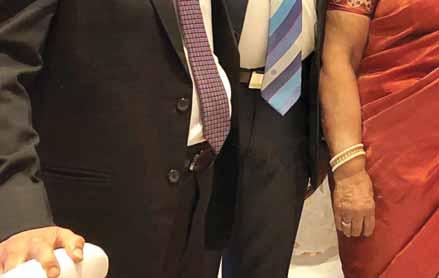

own ability multiplies four times when I am sitting with a group of Rotarians. I get more energy, my brain functions better when I work with others. I am a people’s man and can work better only when there are people around me.”
Mehta had the audience cheering when he said most of the meetings in which he was involved “begin on one day but they don’t end the same day. Not because there is any pressure on us to work like that but that’s how we love to work.”
He was also responding to TRF Trustee Gulam Vahanvaty’s comment that after Kalyan Banerjee had
From L: RID Bharat Pandya, PDG Ashes Ganguly, Nayantara Mahajan, PRIP Kalyan Banerjee, TRF Trustee-nominee Aziz Memon, PRID Ashok Mahajan and Nandita Ganguly.


I get more energy, my brain functions better when I work with others. I am a people’s man and can work better only when there are people around me.
RIPN Shekhar Mehta
completed his term as RI President and came out with the idea of taking up a mega literacy project in South Asia and a memorandum deed had to be finalised, when some of the core members including himself left after long hours of work, Mehta stayed behind with a couple of Rotarians and worked through the night to complete the draft. “Such work was possible only with a band of dedicated Rotarians,” the RIPN added.
Sharing his goals and vision for his presidential year, Mehta said he was banking on huge support from Rotarians of our zones to realise some of his goals. A primary one was getting the Nobel Peace Prize for Rotary’s work in polio, even before it was totally eradicated from the world. “We’ve reached the end; it’s like averting a world war. Earlier 3.5 lakh children used to get afflicted with polio every year; today it’s only 100. If you do the math, more than 40 to 50 lakh children have been saved from this dreaded disease thanks to Rotary. Add to this, 1,100 of our Peace Scholars who are trained to reduce/avert conflict in the world.”
Referring to the thousands of service projects Rotarians do in our zones, Mehta said the tragedy was there were no figures available to quantify that work. But this would change; a website has been developed which will be launched at the Indore
Institute and here all clubs would have to fill in data on the worth of the projects they do.
Complimenting RI District 3141, he said this single district alone did phenomenal work; “I love coming to your district, because each time I come here I learn something new.” (RID Bharat Pandya intervened to say the lead host club for the event — the vintage RC Bombay, which turns 90 years old this year, alone had done projects worth ` 25 crore last year, and it has a record number of 11 AKS members, the highest for any club in the world.)
Urging Rotarians to do mega and structured projects at the national level, he said the literacy programme was a success because it was a structured one. “And we are going to do the same for both preventive health and WinS. Because we have a structure, GoI is partnering with us in literacy and Tata Technologies signed an MoU with us asking us to be their advisers! We can do the same in WinS and Health.”
Maintaining that India was the Kohinoor in the Rotary crown, the RIPN said that as he got ready for RI’s leadership in 2021–22, he would bank heavily on Rotarians in India to take
their country to greater heights. Such as becoming No 1 in membership; we are now around 1.5 lakh; in three years if each Rotarian got just one member, India had the potential to cross the 2.5 lakh mark in membership, beating the US, where unfortunately, membership was declining, to the top post. “And if we have 250,000 Rotarians, our TRF contribution can go up to $40 million; we can have four instead of two directors, and two trustees! And at the CoL, the most effective voice will be that of Indian Rotarians!”
Increasing women’s membership and growing the Rotaract movement were his other priorities, “but for all this you will have to work very hard. Mere felicitations won’t suffice,” he added.
Reiterating his opinion that Mehta and Rashi will leave a distinct mark on RI leadership with their term in 2021–22, PRIP Kalyan Banerjee regaled the audience with an anecdote
Our work in polio is like averting a world war. Earlier 3.5 lakh children used to get today its only 100. Over 40 to 50 lakh children have been saved from this dreaded disease thanks to Rotary.
RIPN Shekhar Mehta
on how he had first met Mehta in 1995 as “a young colt, who thought he knew it all!” He was organising an international seminar in Nepal, to be attended by the then RI President and Queen of Nepal. He asked the late PDG Aloke Mitter to give him some young volunteers from his district which then included Nepal. He was allotted a team of “young and noisy
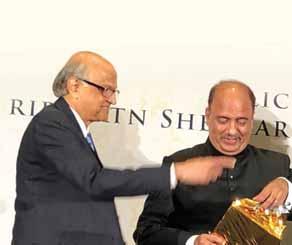
Rotarians led by Shekhar, each of whom thought that he or she knew it all. It was a challenge for both the team and me, because here I was with a group of youngsters who thought organising an international event was a cakewalk and also because I had to harness those energetic but know-all colts to organise the event. Shekhar led the team hard; didn’t care or listen much to me but lo and behold, we had an excellent event.”
From then on, the two had developed “a mutual acceptance, admiration and respect that has lasted a quarter of a century.” Over the years, added Banerjee, he learnt that “this young fellow was a good race horse, a thoroughbred if I may say so, who could win any race.” And he proved himself by first becoming RI Director, then effectively leading the Literacy programme and now getting to RI’s topmost position. While doing all this, he trained people, built excellent teams and created new leaders, “keeping Rashi in good humour and letting her have her way most of the time and also looking after his parents
RIPN Shekhar Mehta releasing the GML of RID 3141 in the presence of (from L) TRF Trustee Gulam Vahanvaty, DG Harjit Singh Talwar, RIDs Bharat Pandya and Kamal Sanghvi.
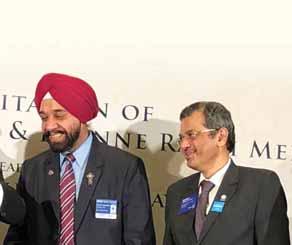


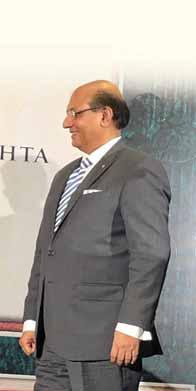


Admitting that he was “not much of a praying person”, RIPN Shekhar Mehta said he and Rashi were “beholden to so many Rotarians from India, and South Asia, for the unimaginable love and affection they have showered on us over the last three months.”
And he was not talking about the high praise that was showered on him during the several felicitation events held in different districts after his nomination as RI President. “In mei to kahi na kahi jyasti ho jaati hei (people tend to go overboard). You treated me like a Shehenshah when you brought me into the hall for this meeting.”
The previous day somebody had said “aap yoga kijiye aur Shekhar ka
dhyan kijiye. Arrey, had bhi karo yaar. (There should be a limit),” he said, striking a lighter note, grinning, and adding, “And today you’ve compared me with Lord Ram and Krishna… for god’s sake…but of course it all comes from love and affection, I know!”
Striking a serious note, Mehta said he was overwhelmed by the extent and intensity of prayers that Rotarians had resorted to prior to his nomination in August. “I received thousands of messages before my selection, and each of them said we are praying for you. PDG Aziz Memon (TRF Trustee Nominee) called me one day when Rashi and I were watching a movie. I told him I’d call him back but he said please come out for a minute.”
When he did, Memon told him that for two years he was praying every
day that Pakistan should become polio-free. “He told me that now over the last 15 days he had started another prayer! And he said now you can return to your film.”
PDG K A Kuriachan (RID 3201) had said that while the selection was on the night of Aug 5 and 6 (in India), he had organised special mass on Aug 5,6 and 7; another Rotarian had vowed to go on foot to the Tirupati temple if Mehta was nominated President. Somebody else had resolved to go to Shirdi to express gratitude. “I did not pray even once that I should get this post, but thousands of Rotarians have done it and I am sure I stand here because of their prayers. I have now started believing in the power of prayer.”

in a manner as though that was the only thing he had to do.”
Congratulating Mehta for his nomination as RI President for 2021–22, RI Director Bharat Pandya said that from 2004, when he first met Mehta, and consequently watched him organise mega events, “I found that his organisational abilities are simply
superb. When he organises something, he puts everything into it, and strives for excellence through intensive planning, passion, enthusiasm and sheer hard work.”
At the Kolkata Institute, Mehta had spoken on “where eagles dare... and I believe he has the leadership qualities of an eagle; acute and far-reaching vision and the ability to see from high up the smallest prey, swoop down and catch it. Eagles are high fliers, and fly at an altitude of 10,000 ft. Just like
Shekhar Mehta has the leadership qualities of an
vision, the ability to see from high up the smallest prey, swoop down and catch it.
Just like an eagle, he dares to dream big, achieve big.
RI Director Bharat Pandya
an eagle, Mehta dares to dream big, achieve big. Eagles are fearless, and when a storm comes, they ride above it. Similarly, Shekhar can meet challenges head on and make a success of whatever he undertakes.”
Drawing the analogy further, Pandya said eagles reinvent themselves and nurture their young; “Shekhar does just that as he believes true leaders are those who build more leaders and not more followers.”
Striking a lighter note, Director Kamal Sanghvi said the speakers had hitherto painted the image of a leader who was a very serious person, with great qualities of leadership, organising ability, etc. “But having spent several years with him, and working very closely with him, I can tell you there is a different angle to the man… he is a great friend to have.” Giving a free flow to his penchant for Urdu couplets, Sanghvi recited a plethora of them, some of them improvised for the occasion and the man in the limelight, to show that Mehta always leaves a lasting
impression on you while claiming your utmost friendship, love and loyalty.
“From the morning people have been asking me what is he like, as I have spent such long years with him… all I can say is that Shekhar is yaaro ka yaar and everything to me.”
Endorsing Mehta’s leadership qualities, TRF Trustee Gulam Vahanvaty said this was evident to anyone who examined the amazing projects that his club RC Calcutta Mahanagar did, and the way in which he steps in with his team to rush relief to victims of natural disasters in the region. It was entirely Mehta’s leadership which had made RILM the driving engine in the task to eradicate illiteracy from South Asia by 2025.
While commending his goal for a Nobel Peace for Rotary, Vahanvaty also urged Mehta to strive to spread Rotary in regions where it had limited presence due to various factors — both China and several countries in the Arab world. Both the regions had substantial wealth and increasing membership in these countries would also benefit TRF and help it do more good in the world, he added.
Congratulating Mehta for the coveted position, PRID Ashok Mahajan said under his leadership RI will scale greater heights. Having known him for many years, he could vouch that Mehta was a “superstar and a dispassionate and even-minded leader who has never run after power; he gives a sense that he is always under control. A man of vision and clarity of thought, he can work with different people as he doesn’t thrust his views on anyone.”
PDG Aziz Memon from Pakistan, RID 3271, who has been nominated TRF Trustee, said he had worked with Mehta for long years in various
RIPN Shekhar Mehta said that the one man in Rotary to whom he most owed the pinnacle he has reached is past RI President Kalyan Banerjee. “Every time he speaks, I learn something new. Nobody else can use words and phrases so well as he does, and I have learnt a lot from him.”
Banerjee was present at every important occasion in his life. “I will never forget that when I held my conference (as DG), his daughter was getting married. But on the second day, leaving all the guests at home, he took an evening flight, came
to Kolkata, delivered his speech and flew back.”
Giving an example of how Banerjee’s guidance to him was never “overbearing”, Mehta said that for the last several years Banerjee and he converse on the phone “every second or third day. He’d call me 80 per cent of the time. But from the day I’ve been selected, his phone calls have become rare. That speaks a lot of the man. Others would have increased the calls, but he has reduced them, because he doesn’t want to overbear his presence on me, and I salute him for this!”
capacities and found him to be an “outstanding leader with great vision and an eye for detail. It will be my honour to work with you in different capacities, and one of them will be to keep the promise we made 40 years ago that no child will suffer from a crippling disease such as polio. Under your leadership we will work harder and ensure a polio-free world.”
To celebrate the RIPN’s visit to Mumbai, Dilip Piramal, a member of RC Bombay, presented a cheque of $120,000 to Mehta.
DGs Harjit Singh Talwar (D 3141), Mohan Chandavarkar (3142), Suhas Vaidya (3132), Girish Masurkar (3170), Rajendra Bhamre (3030) and PDG Prashant Deshmukh (3131) congratulated Mehta on his elevation. Mehta released the GML brought out by DG Talwar.
President of RC Bombay Preeti Mehta and club member Sandip Agarwala addressed the meeting.
In District 3131, RC Pune Sports City, which is celebrating its silver jubilee, hosted the felicitation of RIPN Mehta and Rashi; with the former dressed in the period costume of Marathi hero Peshwa Bajirao. Prior to the event, accompanied by RI Director Kamal Sanghvi, DG Ravi Dhotre, PDG Mahesh Kotbagi, several other PDGs and Rotarians, Mehta participated in an event marking the setting up of 100 handwash stations at 100 schools. This was followed by a CSR meeting with 40 corporate top executives, who pledged to finance over 100 Happy Schools in Pune and Raigad districts through a partnership with Rotary.
At a TRF seminar, a pledge was made to collect around $1.6 million from District 3131.
Pictures by Rasheeda Bhagat Designed by N Krishnamurthy
Several world governments and philanthropists pledged $2.6 billion towards funding a worldwide polio eradication plan that has taken decades to reach what global health specialists say is now the “last mile”. The total amount required is $3.27 billion to support the Polio Endgame Strategy.
The funding, which included $1.08 from the Gates Foundation, will be used to immunise 450 million children against polio each year.
The event, attended by global leaders, was co-hosted by Sheikh Mohamed bin Zayed, Crown Prince of Abu Dhabi, and the Bill and Melinda Gates Foundation, and was held at the magnificent Louvre, the largest art and civilisation museum in the Arabian Peninsula built in collaboration with the French Louvre. The meeting was organised to express support in a tangible manner towards polio eradication through the forum titled Reaching the Last Mile .
“It was a solemn one-day event open to only invitees and sans any frills such as entertainment and other diversions. It focused attention solely on the subject the whole day, with authoritative presentations and discussions by global experts on fields related
Rasheeda Bhagat
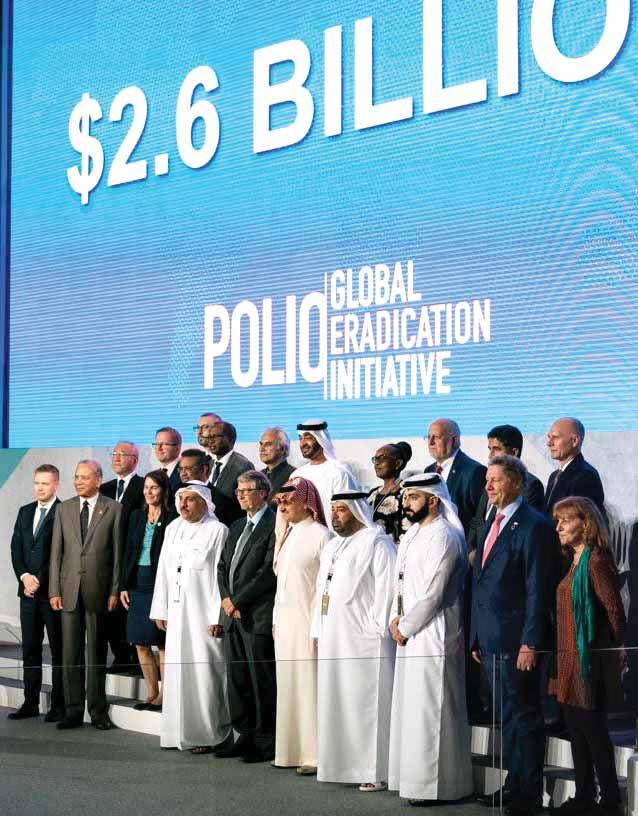

Bill Gates with Abu Dhabi Crown Prince Sheik Mohamed bin Zayed.
to healthcare and polio,” said PRIP and Chair Elect of The Rotary Foundation K R Ravindran. He led the RI delegation at the event and was accompanied by IPPC Chair Mike McGovern and member Judith Diment, and Polio Director Carol Pandak.
The “much-awaited pledging moment had world leaders pledging a total sum of $2.6 billion,” he added. Apart from the Gates Foundation’s pledge of $1.08 billion, Sheik Zayed pledged $160 million. “Other large sums came from the UK government pledging $514.8 million and the US government $215.92 million.
Rotary advocacy played a major role in persuading several governments to support the cause and pledge funds,” Ravindran told Rotary News.
Bill Gates endorses Rotary’s polio battle
The principal role played by Rotary in the End Polio initiative was endorsed by none less than Bill Gates in an interview to Forbes magazine where he was hailed as “both chief funder and fundraiser” for polio. Crediting Rotary International for leading the effort at fundraising internationally for ending polio, Gates said,
“In almost every country, Rotary has members. And that’s very, very helpful to us. Those members have this commitment that goes all the way back to 1988, well before the Gates Foundation had any involvement in the polio fight.” Rotarians in India, Pakistan, Australia, Canada, United States and the United Kingdom, in particular, had been “effective in writing to and showing up to speak to their political leaders. And in those first few years, of course, things went really well and people thought we were getting close. So, it’s great they’ve stuck to
it, even as it’s proven to take longer than we first expected.”
Making a pledge of $150 million on behalf of RI, Ravindran said, “As a spearheading partner of the Global Polio Eradication Initiative, Rotary has been working to eradicate polio for over 30 years.
Rotarians around the world have contributed more than $2 billion to immunise more than 2.5 billion children in 122 countries. On behalf of all Rotarians, I am thrilled to announce our continued, unwavering support and pledge an additional $150 million to the polio eradication effort.”

Earlier, Dr Robert Ray Redfield Jr, Director of the Centre for Disease Control and Prevention, speaking on behalf of the US government, paid a glowing tribute to Rotary when he said, “In 1985, Rotary International committed to see every child in the world vaccinated against polio and to ushering in a polio-free era. It saw the possible and led the world on a quest to eradicate polio. They believed they could make a meaningful impact on the human condition. For them, this was not an aspirational goal. This
was a mindset — a trusted belief that this will get done.”
Apart from participating in this important event, Ravindran and his team had several discussions on the challenges ahead with teams from the Gates Foundation, the Director General of WHO, the Health Ministers of Pakistan (whose government has pledged a sum of $160 million for The Last Mile ) and Afghanistan and representatives of Germany, Canada and Australia.
The WHO had earlier announced that the second of the
In almost every country, Rotary has members which is very helpful. Those members have a commitment going all the way back to 1988, well before the Gates Foundation had any
three types of the polio virus had been eradicated globally. In a press note, it said that while global polio cases have been cut by over 99 per cent, since 1988, when 350,000 cases a year were being found, the Type 1 polio virus is still endemic in Pakistan and Afghanistan, where it has infected 102 people this year. This is an increase over the record low global annual figure of 22 cases in 2017.
Nigeria — the last country in Africa to have cases of wild polio — has not seen wild polio since 2016 and the entire African region could be certified wild polio-free in 2020.
“From supporting one of the world’s largest health workforces, to reaching every last child with vaccines, the Global Polio Eradication Initiative is not only moving us closer to a polio-free world, it’s also building essential health infrastructure to address a range of other health needs,” said WHO Director General Dr Tedros Adhanom Ghebreyesus.
Quoting his countryman and Ethiopia’s champion marathon runner Abebe Bikila, he said at the Abu Dhabi event, that as in a marathon the last mile was always the most difficult one, this was true of polio as well and “we are on that last mile.”
“We are proud to host the GPEI pledging moment in Abu Dhabi and thank all the attendees for their continued commitment to the eradication of polio,” said Reem Al Hashimy, UAE Minister of State for International Cooperation. “Since launching in 2014, the Emirates Polio Campaign has delivered more than 430 million polio vaccines in some of the most remote areas of Pakistan. We remain firm in our mission to reach every last child and believe together we can consign polio to the pages of history.”



TVinay Kamath
A journalist colleague and I were to pose as asylum-seekers and interview illegal immigrants on a container from Belgium to the UK.
Sounded simple enough. Little did we know what we were getting into.
he tragic news that 39 people were found dead in a container in Essex on October 23 is a reminder that smuggling of illegal immigrants from the Continent into the UK still continues. The tragedy brought to mind events from 25 years ago, when I was on an assignment in the UK and Brussels to track the unscrupulous gangs who were behind such human trafficking using containers.
The year was 1995. I had never heard of The Cook Report and didn’t know that it was an investigative television programme lapped up by millions in the UK. Broadcast by Central Television, part of the Independent Television (ITN) network, a Birmingham-based TV news channel,


it was presented by Roger Cook, a burly Australian whose intrepid and often brash ways stirred passions but drew many viewers to his half-hour capsule. Hard-hitting and punchy, Cook’s emphasis was on first-hand reports, often involving impersonations and secret filming that culminated in Cook dramatically confronting the ‘suspect’ with the evidence, all recorded on film. Unsurprisingly, he had been socked, threatened and beaten by the targets of his programme.
It was with this cheerful account of the TV show that Harinder Baweja, then with India Today magazine, and I, both on a British Foreign Office scholarship (the Chevening Young Journalists Fellowship) in the UK, were


assigned to ITN to assist in a story that The Cook Report was doing on illegal immigration into the UK from the Continent. Most of these immigrants were Asian, but a fair number were from Eastern Europe as well. The immigrants were smuggled in on huge container-trailers through Dover, on the English Coast. The trailers had to have British drivers and number plates. With thousands of trucks going back and forth every day, the chances of being stopped were slim.
The programme’s researchers had got wind of one such network in Birmingham involving an AngloCaribbean and an Indian. ITN planted two men posing as drivers who were willing to drive a truck through the border. The idea was to set up a truck with secret cameras to film the whole operation and show up the British Body of young Alan Kurdi, belonging to Kurdish refugees, washed ashore a Mediterranean beach in Turkey.


authorities. And also expose the human trade that was going on undetected. The drivers themselves were offered close to £6,000 each while the immigrants had to cough up a cool £1,800–2,000 to be smuggled through. With hundreds being smuggled through, it was good business alright for the racketeers. Never mind that the poor immigrants were ripped off to get to what they thought was paradise.
The Cook Report was sparing no pounds to get things right. It had hired a mammoth trailer that its decoy drivers would take through for the racketeers. The truck was rigged with secret cameras and microphones and monitors upfront for the drivers to know what was going on inside. As most of the immigrants were either Pakistani or Indians, that’s where Harinder and I came in. We were to pose as immigrants ourselves, get on board this rigged truck and interview the others. It would then be on film. The idea was to get more dope on the network itself, which extended all the way back to Pakistan and India. Sounded simple enough. Little did we know what we were stumbling on to.
who was laughing all the way to the bank.
We led a double life the week we were in Brussels. One was us as us, in a cushy hotel. Once outside, we were down-at-heel immigrants wanting to get across to the UK, where we had relatives who would give us succour and a job. Harinder was clad in Indian clothes to make it look authentic. We went around the night shops, most of them manned by Pakistanis, with our sob story, which got more colourful as it developed.

So we took off for Brussels, Belgium, where most of the immigrants were massed together before being spirited across. The capital of the European Union looked deceptively calm. There were scores of Pakistanis and Indians in the city (mostly from Punjab and Kashmir) who had sought and been granted political asylum. Several manage night shops that are open till late, which the Belgians appreciate. So, it was a little galling to find that, having found a safe haven, many refugees were making a business of sending their hapless brethren across to the UK, after ripping them off for a couple of thousand quid.
In the case of the network ITN had wired into, it was a Belgian kingpin

I was the South Indian who had moved from Madras to a broker’s office in Rajendra Place, Delhi, where Harinder, a Punjabi, was a typist. We got married despite parental opposition and had to run away from home to escape the harassment. Our friend in the UK had asked us to come over and had promised us jobs. Our visa applications were rejected so we decided to smuggle ourselves through.
We created an imaginary agent called Chadha, a Poland-based ruthless Punjabi who had smuggled us across the Continent from Romania, where we had landed. And in Brussels, he ripped us off most of our money and our passports as well. He had vanished after having put us in a hotel and promising to come back after making arrangements to get us through to England.


Our sob story evidently went down well. In Brussels, just by being Indian, it was easy to meet a number of so-called agents who were willing to smuggle one through. The method was either be smuggled across in a trailer or with a false passport. To complete the subterfuge, I had a Paper Mate pen, actually a microphone, clipped casually in my shirt pocket, with a tiny tape recorder tucked away in my jacket to record conversations.
We didn’t think things would happen so fast. Before we knew it, through references and phone numbers, we were talking to agents who were more than eager to take us across for the princely fee of £1,800, as long as they saw the colour of our money. The modus operandi was simple — once the agent got a confirmation from somebody in the UK who was willing to cough up that hefty sum, the agent shoved the immigrants into a safe house to make sure they didn’t run away. And, once across, the UK friend had to come to a similar safe house, cough up the money and take custody of the immigrant. If the contact didn’t cough up the money, the agents rat on the hapless immigrant, who would eventually be deported.
The sting operation
Our best bet was an Antwerp agent called Tusavar Shah, who nonchalantly told us that he could easily get us through to the UK. We raced to Antwerp from Brussels in a car The Cook Report’s researcher, Sylvia Jones, hired. Earlier in the day, a technician, David, drove in from Birmingham (where Central TV is based) right through the night to rig me up. David taped a microphone to my chest, muttering under his breath about how tape wouldn’t stick on hairy chests. The wire ran through my shirt and I concealed the batteries in the pocket of my jeans.

There was more equipment. David had a leather bag, so beat-up and frayed one wouldn’t give it a second glance. One pocket concealed a camera, the size of a toothpaste tube with the lens fitted to a tiny hole, so small you couldn’t get the glint of the lens even if you had your nose six inches from the bag. The central pocket had a small Sony monitor and a recorder with a onehour tape (this was pre-digital era) and the third pocket held batteries for the recorder. There was a small transmitter

in the recorder and, sitting in the car, David could hear our conversation.
Armed with this equipment, Harinder called Shah from the car phone once we got to Antwerp, saying we had come by train from Brussels. We took a cab to his apartment. Just before we entered, I switched on the recorder and we, heart in mouth, went upstairs. Sylvia and David, parked outside as innocent bystanders, said I only had to yell into the microphone if the going got hot. Once we were inside, we had the most explosive conversation with Shah.
With my Hindi being suspect, Harinder did most of the talking, Shah was on the floor sitting on a mattress, and it was ideal for me to place the leather bag on my knee and face the camera towards him. Shah said he was from PoK (Pakistan occupied Kashmir) and had sought asylum in Brussels a couple of years ago. Of course, he was most willing to take us across as long as our friend in the UK coughed up the money. Moved by our tale of woe, he even offered us a discount on the fee of £1,800 each to get us across.
Narrow escape
With hundreds being smuggled through, the racketeers made good business, ripping off the poor immigrants to get them to what they thought was paradise.
their car. After that tense hour, I just had to head for the loo in a pub. When I came out, David was grinning broadly. “I heard you,” he said. I had forgotten to switch off the microphone and transmitter!

Shah was at his reassuring best and said we would not get stopped in the truck. Smelling a good catch in us, he even offered to have us stay with him. Shah looked lethal, all right. If he had discovered that I had a secret camera, he would very likely have slit both our throats right there. He fed us well with some dry fruits. There were a few tense moments when he insisted on knowing where we were staying in Brussels. We goofed as we didn’t do our homework on hotel tariffs and he was surprised we got a hotel in Brussels so cheap. However, we managed to get away unscalped.
Once out, feeling most relieved, we scrammed to the station in a cab, where we were to meet Sylvia and David in

With more taped phone conversations and meetings, we unearthed the leads to a fairly well-entrenched racket. There was Avtar Singh Rana from Punjab who had assured us that as Indian brethren he would ensure that we got across on false passports (remember, ‘Chadha’ had made away with ours!). Sylvia was keen that we get on to a container which Shah would arrange and go right through to the UK and ITN would pay Shah’s agent the money for our eventual release. However, we were reluctant to do that as we were on the British government’s FCO scholarship and our visas to Belgium were almost expiring and we would then have really become illegal immigrants!

Later, following up our leads, ITN had a Pakistani engineer, a British citizen, get in touch with Shah at Antwerp. With his own sob story, a friend and he were smuggled across on a truck, quite similar to the one that ITN had fitted out with cameras et al and which we were to be on (the operation that fizzled out). Tariq, the Pakistani, carried a secret camera with him, but unfortunately the batteries ran out so he did not get any footage of the actual crossing in the truck. But he was holed up in the truck for 22 hours with dozens of other immigrants without any food or water. Central TV set up a contact in the UK
and coughed up £2,000 for his release from the agents.
Telecast to millions of viewers Cook’s programme on the immigrants was telecast on May 23, 1995, in the UK on the ITN network. Eight-anda-half million viewers watched it in the UK. Despite my apprehensions about it being a rabidly anti-immigrant programme that would say ‘these guys are coming in and taking away our jobs’ it was fairly sympathetic to the immigrants who came in. It talked about their exploitation in the UK and the sweatshops they ended up in, constantly in fear of being deported. Cook, in typical fashion, confronted the Anglo-Caribbean and the Indian in Birmingham on film. The former reacted fairly coolly and said he would get back to Cook about the evidence he had (they had secretly filmed the two when they were negotiating with the two drivers ITN had set up). The Indian reacted violently and threatened that he would fix Cook.


Some of the secret footage I had taken of Tusavar Shah was shown in the programme. But Belgian law, funnily enough, unlike the English, did not allow the police to cooperate with the media or take cognisance of media reports. I never got to know if they had launched investigations against the likes of Tusavar Shah. For me, after skirting with danger and leading a double identity in Brussels, it was a relief to get ‘back home’ to London and continue with my scholarship programme. Tusavar Shah claimed he had a long hand. He had even offered to fix our imaginary Chadha in Poland to get our money back. If he’s still around in the immigrant-smuggling business, I sure hope his long hand doesn’t extend to India!
© The Hindu BusinessLine; the writer is a Senior Associate Editor with the newspaper.
Rotary Club of Patna Midtown, RID 3250, has set up the R S Cancer Diagnostic Centre at the Savera Cancer and Multispecialty Hospital in Patna. RID Kamal Sanghvi, who inaugurated the facility recently, complimented the Rotarians for the initiative. “You have understood and appreciate the importance of early detection for successful treatment of cancer. This new facility will certainly save many lives and is a boon especially for the economically-weak communities for whom cancer diagnosis and treatment is a distant dream,” he said.
PDG Vivek Kumar said that this global grant project was initiated and approved during his term in
Convention Countdown
When you are in Honolulu for the Rotary International Convention, June 6–10, make sure to save room for dessert, because the Hawaiian Islands have some sweet treats in store for you.
Shave ice (calling it shaved ice or a snow cone is a quick way of revealing you’re not from around here) was introduced to Hawaii by Japanese immigrants. Inspired by a Japanese frozen treat called kakigo-ri, they hand-shaved blocks of ice to create mounds of delicate crystals, then flavoured the ice with the juice of tropical fruits.

2017–18 and was one of his dream projects.
DG Gopal Khemka thanked Kumar and the club’s past president Sunit Chandra for making the facility
Hank Sartin
These days, the ice is usually shaved by machine and is often served over ice cream for an extra layer of indulgence. Flavours range from local favourites such as papaya, lychee and pineapple to the more exotic (for Hawaii)
a reality. DGE Rajan Gandotra, DGN Pratim Banerjee, Club President Manoj Gupta and Secretary Gaurav Prashant were also present at the event.
black cherry, apple and chocolate.
If your taste runs more to fried dough, you can indulge in malasadas , brought to the islands by Portuguese immigrants. In Hawaii, these luscious yeast doughnuts (the batter is

enriched with lots of eggs, butter, and sometimes evaporated or fresh milk) have fillings such as custard, coconut pudding, chocolate pudding and guava. Whichever treat you prefer, try to sample the variety from different shops. Many have their own special flavours and fillings.

Don’t miss the 2020 Rotary Convention in Honolulu. Register at riconvention.org by Dec 15 to save.
V Muthukumaran
An audit report card on the content, design and visual appeal of regional Rotary magazines is on the cards to expand its reach among Rotarians and others. This annual report will also consider the feedback received from a readership survey to be done in 2020–21 to understand the pulse and views of the subscribers, said David Alexander, Chief Communications Officer of RI.
In a presentation at the twoday Asia-Pacific Regional Editors Seminar hosted by Rotary News magazine, India, in Chennai, he said the upcoming licensing review of regional magazines would suggest an Advisory Board with a two-year tenure to come up with policy guidelines and initiatives to shore up the public image of Rotary through the magazines.
Presenting a communications update that would highlight Rotary’s new strategic action plan, he said the magazines need to increase their impact and expand their reach by also “engaging external audiences with content that highlights projects with broad and lasting impact.”
“We need a right communications approach and content strategy with a common list of priorities to take forward Rotary magazines. There are external factors such as
technology, demography, social and competitive factors as well as internal drivers, namely stagnant membership, a complex hierarchy, the duality of tenure-based service versus skill-based expertise, lack of continuity and a post-polio free world which make us sit up and prepare for the challenges ahead,” elaborated Alexander.
Urging editors to vigorously adopt and propagate the “People of Action” image of Rotarians, he referred to RI’s new Vision
Magazines will have to comply with quality benchmarks in content delivery and design. A readership survey will be done for all magazines to enhance their reach and quality.
Donna Cotter RI Coordinator Regional Magazines

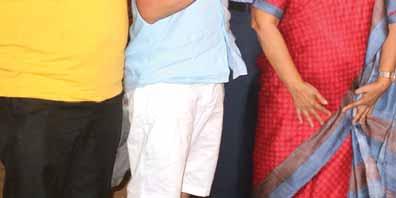

Statement: “Together we see a world where people unite and take action to create a lasting change across the globe, in our communities and in ourselves.”
Focusing on the challenges ahead, Alexander said these included increasing membership, leveraging the polio legacy, reporting impactful projects, expanding reach with thrust on diversity, member participation and creating new channels in Rotary; and embracing research, innovation and taking risks. The Strategic Committee deliberations had urged that “we have to change our core structure right from the club-level. Our first-year initiatives will be on elevating Rotaract (and Rotaractors), and to develop online tools for training by the end of this Rotary year. Besides an effective database on Rotaractors, we need to

David Alexander, RI’s Chief Communications Officer, and Donna Cotter, Coordinator, Regional Magazines.
engage around 250,000 of them at the Rotary club-level,” he opined. Regional magazines need to appoint a public image team, adopt the People of Action message as a key mission in their stories and make good use of online tools at the Brand Centre, he said. “Talks are on with the Gates Foundation to expand its relationship with Rotary and an announcement will be made in the
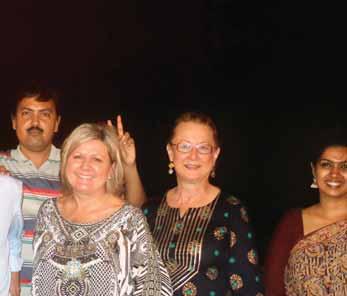
David Alexander and Donna Cotter with Rasheeda Bhagat (Editor, Rotary News); Yotharvut Vanit (Editor-in-Chief, Rotary Thailand); Henry Y T Shao (Editor, Taiwan Rotary); Gay Kiddle (General Manager, Rotary Down Under from Australia); Jyoti Rai, Senior PR Coordinator, RISAO, and Rotary News staff — K Senthilkumar, K Vishwanathan, V Muthukumaran and Kiran Zehra.
We need a right communications approach and content strategy with a common list of priorities to take forward Rotary magazines.
David Alexander RI’s Chief Communications Officer


next International Assembly. And WHO is all set to certify Africa polio-free by the middle of 2020. Rotary clubs must share the success stories of polio with their communities.”
One of the key highlights of the new licence review is that publishers shall be permitted to sell the magazines in retail outlets after getting permission from the RI Board. “The Advisory Board will come out with guidelines and instructions to enhance the magazine’s quality. The domains and URLs will be standardised.” When content is used from external sources like blogs and news websites, disclaimers will have to be carried, said Donna Cotter, RI Coordinator, Regional Magazines.
With new branding standards coming into force, “magazines
will have to comply with quality benchmarks in content delivery and design processes.” A readership survey having not more than 6–7 questions will be done for all magazines to enhance the magazines’ reach and quality. The overall design must support and be in sync with the strategic vision of Rotary, she said.
The survey being discussed and formulated by the Communications Team would be a non-intimidating way of getting opinions and feedback from subscribers who would have an opportunity to express their opinions on ways to improve the magazines. “Our research team is working on the possible questions to make the surveys effective and the results will be shared with the regional editors,” said Donna.
With a literacy rate of 74 per cent and many rural markets in India yet to be explored by the print media, “newspapers and magazines are here to stay for at least 20–30 years in India. The doomsayers of print have bitten the dust as many dailies have reported a jump in circulation of late,” said Rotary News Editor Rasheeda Bhagat. “Our print edition is supplemented by an interactive website where individual articles and pictures are posted and an e-version in a pdf format with regular online updates from Rotary.org and elsewhere.”


Against a circulation of 1.28 lakh copies in print, only 4,000 Rotarians, barely three per cent, have opted for the digital version. “That tells us that print is still the king,” she said.
Also, projects that can’t go into the magazine are now carried in an exclusive e-version titled Rotary News Plus, which comes out on the 15th of every month. “We also bring out Rotaract News every quarter, print a couple of hundred copies which are sent to DRRs, DGs and senior Rotary leaders in India and Evanston. It is available online.”
senior Rotary leadership on key issues. Rotary Foundation (India) is creating an exclusive website to mark the centenary celebrations of Rotary in India and share success stories. “We’re getting a PR agency to develop a good interface with the public and the media,” she said.
One of the major challenges that all editors face is that magazines aren’t updated about new or terminated members in a timely manner.
A major challenge all editors face is that magazines aren’t updated about new or terminated members in a timely manner.
A media survey has shown that 13,500 stories and articles were published on water and sanitation issues in Indian newspapers and magazines between March and August 2019, said Jyoti Rai, Senior PR Coordinator at RISAO, New Delhi. “This only points to the fact that people can relate directly to stories of human development and sufferings, if they are written well.”
Jyoti’s team at RISAO is working to foster knowledge sharing, collaboration on new ideas, initiatives and to create a joint front with
In their video messages RI Directors Bharat Pandya and Kamal Sanghvi highlighted the importance of the Rotary magazines as they were an important communication tool, and urged the editors to continue to improve their quality.
Gay Kiddle, General Managar, Rotary Down Under from Australia; Henry Y T Shao, Editor, Taiwan Rotary; and Yotharvut Vanit, Editor-in-Chief, Rotary Thailand shared their views and difficulties in running the magazine with Rotarians not paying their dues and not reporting the membership details in time.
Designed by Krishnapratheesh S
Guidelines on Major Donor recognition / Global Grant beneficiaries
In view of several instances of non-compliance of guidelines for Major Donor and Major Gifts recognition in the region, the policy is being reiterated here:
As contributions accumulate, donors may be recognised as they reach each successive level.
Only outright personal contributions including Annual Fund, Endowment Fund, and other restricted gifts to The Rotary Foundation qualify for Major Donor recognition.
Major Donor recognition is reserved for individuals, couples, non-Rotary-affiliated Foundations, and corporations. Contributions from donor spouses are typically combined for Major Donor recognition purposes, if they request in writing. A club or district is not eligible for this recognition.
Major Donor contributions, including AKS contributions are the personal gifts of donors and District Funds or contributions from any fundraising activities, beneficiaries/cooperating organisations should not be utilised to match contributions for major donor recognitions or providing/ implementing global grant projects.
Additionally, clubs and districts should also keep following information in mind on beneficiary eligibility, activities, level of competence etc, while applying for a global grant:
TRF will accept contributions for global grants submitted by Rotary clubs and districts, that are contributed by Rotarians,
clubs and districts, and nonRotarians and non-Rotary entities as long as there is no conflict of interest as defined in Rotary Foundation Code of Policies, Section 10.030, that project funds do not come from a beneficiary or cooperating organisation involved in the project, and provided that this funding is used for projects that are designed and implemented by Rotary clubs and districts, subject to Foundation stewardship and reporting requirements.
Non-member cash contributions — donations to the project account or to TRF from other organisations or parties (not including cooperating organisations or beneficiaries of the project) are eligible to be matched 50 per cent by the World Fund for projects that are designed and implemented by Rotary clubs and districts, subject to Foundation stewardship and reporting requirements.
Follow Rotary’s Privacy Statement for Personal Data outlined in Section 26.080 of the Rotary Code of Policies. Do not include personal data (name, age or date of birth, or other identifying information) of grant beneficiaries or images of them in grant applications and reports unless the Foundation requests it and you have a written consent of the beneficiary. Inappropriately including that personal data can cause delays in the grant process while we ensure compliance with Rotary’s Privacy Policy. Continuous or excessive support (defined as any cooperating
organisation receiving $2 million or more in World Fund over a three-year period) of any one beneficiary, entity, or community should be avoided. Grant funds will be sent to the account listed in the Grant Centre and should be in that account until they’re used to directly pay project expenses. It means that a payment should be made directly to a project vendor or cooperating or beneficiary organisation. Project funds should not be paid to anyone before the actual expenses have been made or services have been delivered. Organisations being reimbursed for project expenses should give the Rotary project sponsors copies of the original invoice or receipt before they’ll be paid. The people with signing authority on the bank account must be members of the sponsoring club or district.
Provide beneficiary information, including photographs, newspaper clippings, or letters or appreciation from beneficiaries or beneficiary organisation along with the final report.
The Foundation began a pilot of constructing low-cost shelters or simple schools with global grants on Jan 1, 2017. That pilot concludes on Dec 31, 2019. No low-cost shelter or simple school applications may be submitted to TRF after Dec 31, 2019. The Trustees will decide in April 2020 on whether to retain these project types within global grants.

Rasheeda Bhagat
Rotary in India has signed an MoU with the Fairfax India Charitable Foundation to put up, in a partnership of 75:25, dialysis machines to serve the underprivileged in government hospitals across the country.
The MoU was signed in Mumbai recently between the Foundation CEO Abraham Alapatt with all the district governors representing Maharashtra State. RI Director Bharat Pandya, who has launched a massive drive across the
Prime Minister Narendra Modi suggested to our Fairfax India CEO that we take up a dialysis project as there is a big gap in demand and facilities available in India.
Abraham Alapatt CEO, Fairfax India Chairtable Foundation

From L (standing): TRF Trustee Gulam Vahanvaty, DG Mohan Chandavarkar, RIPN Shekhar Mehta, RID Bharat Pandya, Fairfax Foundation CEO Abraham Alapatt, DGs Suhas Vaidya, Girish Masurkar and RID Kamal Sanghvi.
Seated: DGs Harjit Singh Talwar, Rajendra Bhamre and PDG Prashant Deshmukh.
country on prevention of non-communicable diseases, said the Foundation had negotiated with vendors effective costing under which a dialysis machine would cost `4.3 lakh with an extended warranty of five years. To begin with, the
districts in Maharashtra would work with Fairfax to set up the dialysis machines in the State; Rotary would raise 75 per cent of the amount, with Fairfax adding the rest.
Alapatt explained that the Foundation had embarked on this mission
When Rotarians raise money for dialysis machines, the Rotary logo will be on it and if the majority/all the machines in a centre are provided by Rotary, it will bear our name.
Bharat
Pandya
RI Director
to set up 1,000 dialysis machines across India as in a recent meeting of Fairfax India CEO with Prime Minister Narendra Modi, the PM had asked him to take up a dialysis project as there is a big gap in demand for dialysis and the facilities available in India. “We’ve already put up about 500 across the country; we work with the Central Health Ministry, and set up the machines in the district hospitals. The model works on a publicprivate partnership; the government provides the building and we provide the machines.”
Under the PM’s insurance scheme, the dialysis, which costs at least `2,000 or more in a private hospital, is completely free of cost for BPL patients. Typically, to make it viable, one unit requires about five machines; 90 centres are already operational under this scheme, he said.
Dr Pandya said at present there are about 3,600 machines in Maharashtra and most of them in big cities and towns. This project will help reach dialysis to poor patients in areas deficient in this service. “We want to implement this project pan India, but today as the DGs from Maharashtra are present, we will begin with this State.” Once Rotarians raise the money for dialysis machines, the Rotary logo will be on it and “if the majority or all the machines in a centre are provided by Rotary, or a single club, such as RC Bombay, then its name will be displayed at the entrance of that centre.”
He thanked Rtn Rakesh Bhargav from RID 3131 for doing the groundwork for this MoU. RIPN Shekhar Mehta, RI Director Kamal Sanghvi and TRF Trustee Gulam Vahanvaty were also present during the signing of the MoU.
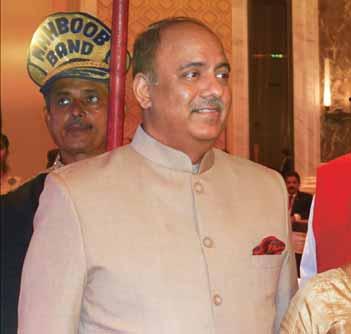
RIPN Shekhar Mehta with his mother Vallabh Kumari, wife Rashi and daughter-in-law Geeta. PRIP Kalyan Banerjee, RID Kamal Sanghvi, TRF Trustee Gulam Vahanvaty and PRID Manoj Desai are also seen.










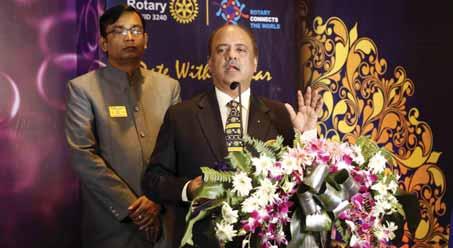
DGE Subhasish Chatterjee is also in
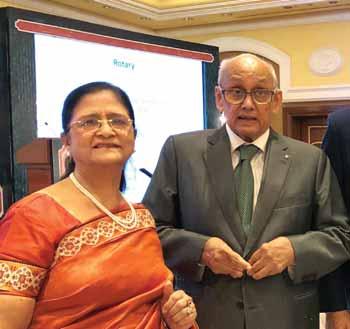







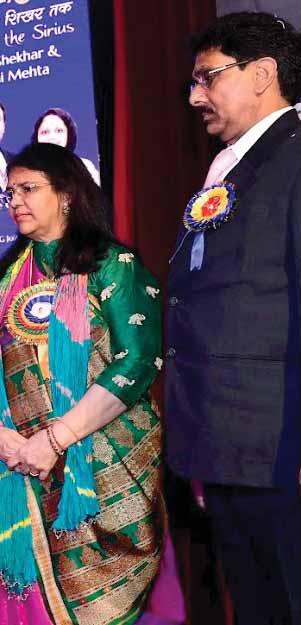



Above: RIPN Mehta and Rashi with PDG Vijay Jalan in Mumbai.

Left: RIPN Mehta and Rashi lighting a lamp at Jaipur in the presence of (from L) PDGs Ajay Kala, Ashok Gupta, PRID Manoj Desai, DGN Ashok Mangal, DG Bina Desai and DGE Rajesh Agarwal.
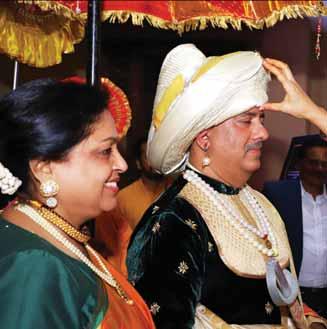


RIPN Mehta and Rashi being welcomed in Pune.

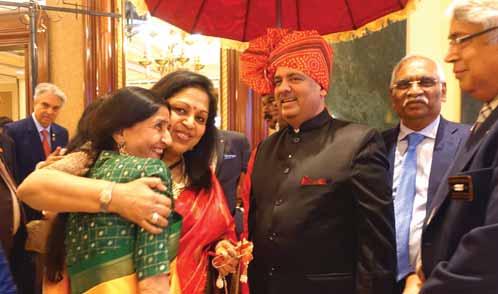
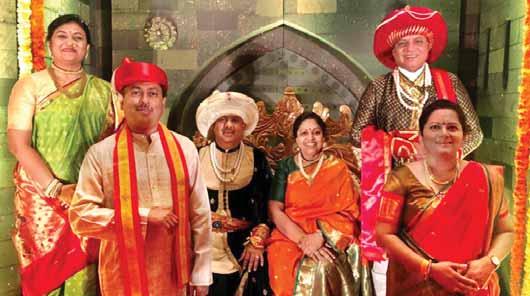
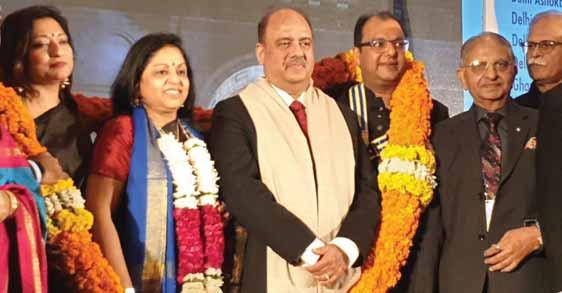
RIPN Mehta and Rashi being felicitated by DG (RID 3012) Deepak Gupta and his wife Reena in Delhi.

Kiran Zehra

Rotarians from RC Dombivli Midtown, RI District 3141, celebrated Rakshabandhan with the jawans at the BSF outpost at Dholavira in Kutch, Gujarat. Women Rotarians tied rakhi to over 125 jawans. “It was an emotional moment when one of the soldiers pulled out
a rakhi he received from his sister through post and requested me to tie it,” said Project Chairman Rutuja Patil. The women were surprised to know that most of the soldiers do not go home to celebrate festivals so that they can fulfill their duty of safeguarding the nation.
“It was a great privilege for us to meet the soldiers and celebrate a festival with them. The smile on their faces made the 850-mile journey from Mumbai to Kutch totally worthwhile,” said Club President Anil Kulkarni and thanked the women in the club for making the rakhis and sweets at home for the jawans and getting school students to write letters of gratitude for the soldiers. These letters were handed over to the BSF jawans who were deeply touched by the warm gesture of the Rotarians. Kishor Adhalkar, a club member, had sought permission from the BSF outpost for celebrating the festival. The Rotarians shared a meal with the jawans and enjoyed a cultural programme hosted by the girls of a nearby village.

We seek your generous contribution to support our Dharmasala that provides food and shelter for patients and attenders.
It sees 160-180 inmates a day. Our monthly expenses Rs 6 lakh Exemption for donations under 35 (I) (ii) (Research); 80 G
Dr V Shanta, Chairman
Dr G Selvaluxmy, Director Cancer Institute (WIA) Adyar, Chennai – 600 020. Phone: +914424910754. Email: caninst@md2.vsnl.net.in
Rasheeda Bhagat
Combining two of Rotary’s core areas — enhancing livelihood and protecting the environment — into a single project, and adding a third dimension critical to the distressed Indian farmer, Rotary Club of Nasik, RI District 3030, has successfully launched a project making organic farming profitable and sustainable for farmers of the region.
The club is celebrating its 75th year. Last year, under the leadership of agricultural expert Hemraj Rajput, a member of the club, who is also a professor at the local agriculture university, the club introduced a Rotary Organic Bazaar at its own Rotary Hall in the city.
Says Club Secretary and Presidentnominee Shreeya Kulkarni, the idea was to do a service project that would benefit “our farmers as farming is the backbone of Indian economy. We all know that the middlemen take away most of the profits for the crops that farmers grow. Also, as in India farming is mostly dependent on seasonal rainfall, income from it is both uncertain and unpredictable.”
Rajput, the expert, suggested that farmers should be dissuaded from using chemicals and pesticides for cash crops
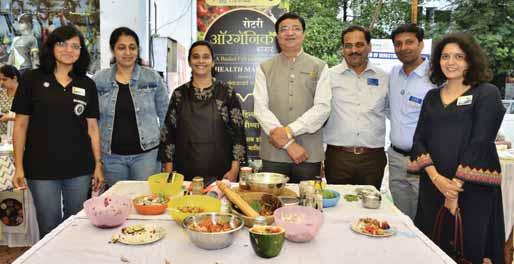

such as vegetables and fruits and hence it was decided to choose organic farmers and give them a marketing mechanism to sell their produce without middlemen cutting into their income.
The Rotary Organic Bazaar was advertised through social media, fliers and pamphlets and initially the bazaar was held on alternate Tuesdays. To make it more vibrant and involve and benefit more farmers and make the initiative sustainable, “a committee was formed for this project under the chairmanship of Tushar Ugale.”
The committee decided that to make this initiative even more successful it
should be moved to a more customerfriendly and prime location in the city and organised on the second and fourth Sunday of every month. The Rotarians zeroed in on a popular hall centrally located in the city and “we rented the car park for `5,000 and turned it into a place for the farmers to display their produce.” An interesting tidbit she shares is that as the prices of onions have soared in Maharashtra as well as the rest of India, “last week the farmers brought organic onions which they priced at `30 a kg. They were of very good quality and the entire lot was sold out in 30 minutes!”
To make the project sustainable, the committee has worked on the economics of the bazaar, framed detailed rules and guidelines and almost 80 per cent of the space is pre-booked on a yearly membership basis. Now the bazaar is on an auto mode, says Community Service Director Omprakash Rawat.
The farmers bring in all kinds of vegetables and fruits. The club tries to encourage even marginal and
tribal farmers to participate. Shreeya shares an interesting nugget: During September-October, tribal farmers grow a vegetable called ran bhajya (jungle vegetables, in Marathi). “This is very nutritious and rich in iron and calcium but is not easily available and many people don’t know how to prepare it.”
So during market days, the tribal farmers who grow and consume this vegetable demonstrated how to prepare
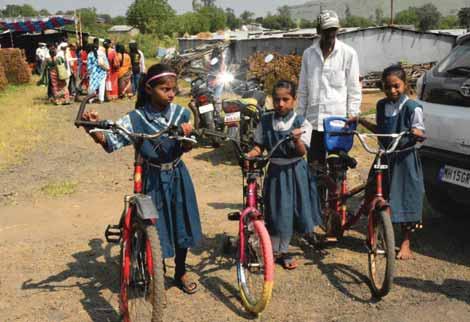

it. This way, value addition is done; self-help groups of women, engaged in farming, are encouraged to bring in their organic produce, as well as dry items like papad, pickles, etc. “And during the Diwali season, we asked them to display homemade traditional sweets, and they also held a demo of how to make different types of salad,” says Shreeya.
Club President Manish Chindhade adds that seeing the success of the organic bazaar the club members are planning to make it a weekly event and also organise a workshop for farmers where they will be trained on better marketing techniques and other features associated with getting more profit from farming.
In another service project undertaken at the village Darewadi, situated in a remote area of the Igatpuri region, where villagers were displaced for the building of a dam, the club is giving bicycles to girl students to reach school. Says Chindhade, “Half of this village is on the top of a hill and half the villagers are still living in temporary tin sheds at the base. Thus many primary school students have to travel miles to reach their school, and several girls dropped out due to lack of transportation.”
And frequent landslides due to heavy rains added to the students’ difficulty. As the village is located in a scenic area, during a Sunday morning trek, the Rotarians chanced upon the difficulties faced by the villagers, particularly the students. The club members identified their requirements such as raincoats, shoes, computers, cycles for girls. It was decided to distribute 75 cycles and 75 computer systems, and 25 old bicycles, repaired and refurbished, have been handed over to the girls. Two computers systems and footwear, raincoats, blankets for elderly citizens and sweets during Diwali were also given.

As Rotary Club of Calcutta, RID 3291, is poised to celebrate its 100 th charter day in Jan 2020, its members go on a flashback journey of the lives they have touched through a variety of projects over the last century. The club was installed in Sep 1919 and chartered in Jan 1920. From a strength of 21, it has grown to 240 members today, and has sponsored 28 Rotary clubs in India, Pakistan and Bangladesh. It has the distinction of having the first RI President from India in Nitish Laharry and getting leaders such as

Mahatma Gandhi and the Dalai Lama to address the club.
Here is a glimpse into some of the life-transforming activities of the club.
The Annual Children’s Treat is one of the long-running projects that was begun in 1925 with an aim to gift ‘a day of sunshine’ to children from marginalised families across Kolkata. What began with 200 children from five orphanages, gradually swelled to 1,750 children from various orphanages, NGOs and other institutions. “The picnic is meant to bolster their morale and confidence,” says club member Amit Ghosh. They enjoy their

Delegates from other districts visiting the Nitish Laharry Children’s Library at the Rotary Sadan in Kolkata.




day out each year at the Nicco Park from dawn to dusk and are treated to a fine spread of lunch and snacks. They go back home loaded with memories and a gift pack from the Rotarians. Club member Rajiv Kaul owns the 40-acre park with 35 exciting attractions, and his magnanimity is helping the club conduct the programme for the children for so many years. The park is shut for outsiders on this occasion and reserved for the exclusive use of these children.
The children’s immunisation project, that started in 2009 at the St Thomas Home in Howrah, has






immunised 75,000 children against 20 diseases through a series of global grants worth $300,000. “We aim to vaccinate 25,000 children this year,” says Ghosh. The immunisation activity is executed every two months at the Home which houses TB patients abandoned by their families. “We focus on immunising children of these patients and will be including cervical cancer inoculation for 8–14 year-old girls.”
The club is facilitating vocational courses for women at the Home through a global grant of $100,000.
“I have learnt to stitch like a professional and want to become a fashion


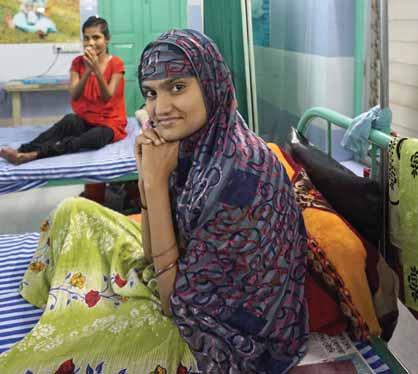


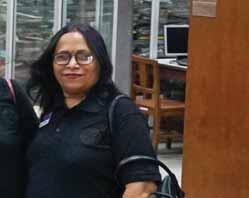


designer,” says Zoya Ali, greeting us cheerfully from her bed at the Home. She was abandoned by her family after she contracted TB six months ago. Thanks to the club, she is learning tailoring, along with many other patients.
As we enter the sprawling campus of the Howrah South Point Home, we are greeted with Bengali poems sung by little children. The club provides medical care for the differently-abled children housed here. As part of the centenary project, the club, through a global grant with a German club, has initiated construction of a bridge school for underprivileged children here.
Ghosh points out that the club had played a role in persuading the government in 1927 to construct what is today the Howrah bridge. It was earlier a dilapidated pontoon bridge.
The club was instrumental in introducing broccoli to the city after the members undertook an integrated village development programme at Begumpur in 1987, and a similar


programme was taken up at Bishnupur with the help of an RCC that works for holistic development there.
The Rotary Sadan is an iconic monument for which PRIP Rajendra Saboo laid the foundation stone in 1992. It houses the Nitish Laharry Children’s Library and the archives section holds Rotary memorabilia collected over the years. It also houses a vocational training centre that provides courses for women from marginalised families.
A tie up with the Rabindranath Tagore International Institute of Cardiac Sciences and a global grant have helped the club save 700 heart patients so far. “We aim to touch 1,000 lives during the year,” says Saumen Ray, Centenary Committee Chair, as he lists out other projects to commemorate the milestone year. These include construction of a hostel for
a tribal school, screening 10,000 children for avoidable blindness and operating on 1,000 children, and making 1,000 adults literate. Over the years the club has constructed 600 toilets in schools, three pay and use toilets across the city and sunk 200 borewells, against a centenary target of 1,000 toilets, 10 public toilets and 300 borewells. Twelve villages have been made open-defecation free and 12 more will be targeted this year.
“The fact that the club is turning 100 has given us all fresh energy and every day we get new ideas from various members, some of which are too good to pass. This year has been a breeze and we still have a lot more programmes lined up for the year. But nothing to beat Club President Purnendu’s enthusiasm,” smiles Ray.
Pictures by Jaishree




















That acts of kindness are seldom forgotten can be seen from a Facebook post of the parents of three-year-old Miracle, a Nigerian girl, on the completion of one year of her successful heart surgery facilitated in Kolkata by RC
This year, on Nov 2, Miracle’s parents, Joseph Chukwumaije and his wife, shared their joy at their child’s good health through a warm and loving FB post. It recalled how on this very day last year “Miracle underwent (an) open heart surgery at Narayana Super Specialist Hospital, Howrah, India.
you that helped to save her life. As I sat back reminiscing the way we had travelled from Nigeria to India (unknown land and unknown people), it was hope and confidence in these unknown people’s goodness that was our major luggage during this journey.”


I am writing to thank God and all of


But their anxiety had evaporated “when daddy R K Bubna called out
But t their r y had d evapor t ated d “wwhhen n d y R K B Bubna called out


‘Baby Miracle’, as we came out of the Kolkata airport terminal.”
The extent to which the larger Rotary family envelops strangers in its warm grasp just because they also wear the ‘Rotary’ label, can be seen from the gratitude expressed in this post. It recalls how the Nigerian family was treated by the Kolkata Rotarians as a “royal family; we were put up in the hospital’s private ward, served special food whenever we requested and all our medical expenses were paid. We cannot forget the love with which you welcomed us. Daddy R K Bubna had always come with food from the store because he was sensitive to our background as foreigners.”
To provide a recap of the article carried in Rotary News (Jan 2019), last year, RC Belur had jumped in to help the Nigerian child following an FB post, where Harshad Raveshia, a member of Rotary eClub One (Houston, US, RID 5450), had requested emergency medical help for the child as a team of US doctors visiting Nigeria could not operate on Miracle for want of adequate equipment and other facilities in Nigerian hospitals.
After seeing this post, Bubna contacted Raveshia and got from him the medical reports of the child, which were shown to doctors at the Narayana Super Specialty Hospital in Howrah. RC Belur has a partnership with this hospital for cardiac treatment of poor children and adults. Once the hospital confirmed that surgery could be performed on Miracle, who, apart from a hole in the heart, also had some other complications related to a very small left artery.
The surgery was done on Nov 2, 2018, and the child discharged on Nov 8. Club members Ramesh Tiwari and Vishnu Dhandhania took care of the arrangements to make the family’s stay comfortable in Kolkata. This project was undertaken in partnership with Rotary eClub One and RC

Greater Nigeria, RID 9125, through a global grant from TRF. In the latest FB post, Miracle’s parents thank all these Rotarians by name, leaving the best part of the news for the last.
Not only that Miracle is now fine and is attending school, but she now has a baby brother. The parents had put away the thought of having another child due to Miracle’s heart problem, “but thanks to you all, she is now well and in school with her mates. May
God almighty bless you all and your family abundantly.”
Says an overwhelmed Bubna, “I have been in Rotary for over three decades, and have done so many service projects, including with international partners. But this has been the best project of my life, as I was instrumental, by the grace of god, in giving a second life to Miracle, and bringing the smile back on her parents’ faces.”
Rotary clubs across the country observed
World Polio Day (Oct 24) by sensitising the public on the need to
immunise children to prevent life-threatening illnesses, besides maintaining the momentum for immunisation against polio though India is declared polio-free.
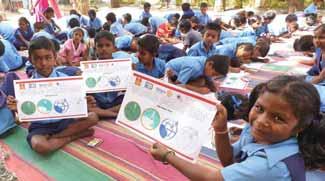
Participants of a drawing competition organised by RID 3190.
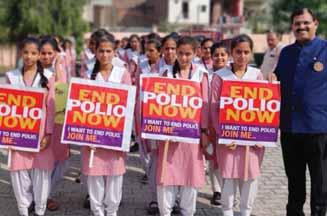
In Delhi, RI South Asia Office (RISAO) joined hands with RC Delhi Regency Next, RID 3011, to flag off Mission
Indradhanush Message Car for creating awareness across the regions. India National PolioPlus Committee (INPPC) Chairman


Sanjeev Rai Mehra, TRF-Head Sanjay Parmar and PolioPlus Programme Coordinator Sandeep Kashyap from RISAO were present at the mega events in Gurgaon.
RID 3190 led by DG Dr Sameer Hariani and District PolioPlus Committee Chairman D Rukmangada hosted three major events in Bengaluru to mark the World Polio Day.
Deepak Kapur flagged off the car from RISAO office, in the presence of DG Suresh Bhasin and other Rotarians.
Rotary clubs in Gurgaon, RID 3011, organised a Rotary Health Carnival at the DLF Cyber City. It included a mega health
camp for mammography and cancer detection, dental, diabetes and eye check-ups and blood donation camp. PDG Dr Sushil Khurana, DGE
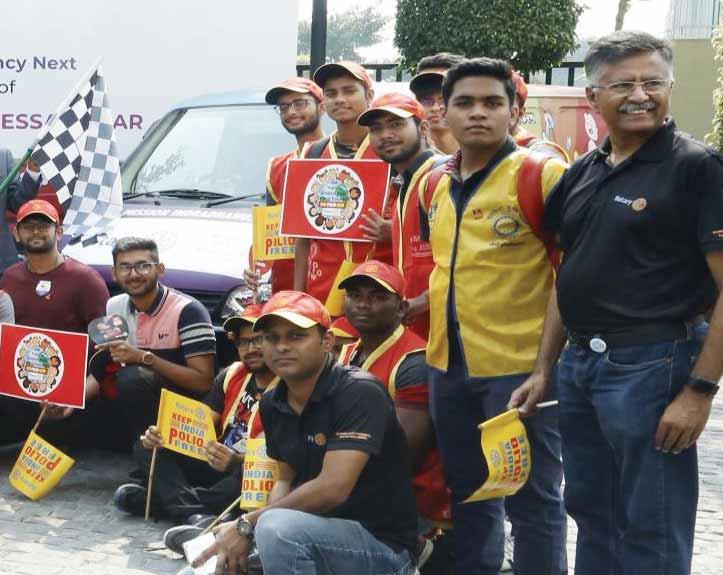
Over 4,500 children took part in Polio Colora-thon, a drawing contest organised across the district by 30 Rotary clubs. Portraits of Dr Jonas Salk and Dr Albert Sabin, the inventors of polio vaccine, were unveiled at the Paediatric section of Vanivilas Hospital in Bengaluru. City Police Commissioner Bhaskar Rao was the chief guest at the Torchlight Peace Assembly in which a galaxy of Rotary leaders, Rotaractors and the public took part. A flash mob dance, Rotary message vans and candle lights were the major highlights at the Peace Assembly.

In Hoshiarpur, Punjab, DG Sunil Nagpal, RID 3070, flagged off a rally by school girls which was organised by the local clubs with support from the Health Department. Designed by L Gunasekaran
Rasheeda Bhagat
When as the DGE of RI District 3201, Madhav Chandran was preparing to undertake one of the most exciting journeys of a Rotary leader’s life, that to the International Assembly in San Diego, in January 2019, like most governors-elect, he too was scratching his head on what gift to take for the 500-odd DGEs attending the event.
He first thought of all the typical souvenirs associated with Kerala, including elephants and houseboats. “But then I didn’t want to take anything that would make my luggage too heavy, as Sujata and I would have limited weight for our baggage. Next, I thought, instead of giving a souvenir to all and sundry, why not reduce the numbers, and give it to only those who are connected with our district.”
And what better connection in Rotary than service projects? So Chandran got in touch with RISAO in Delhi to get details of all the projects his district (then RID 320) had done with international clubs and districts. “They were very cooperative and gave me a full Excel sheet starting from 1990 with names of clubs and districts who had done joint projects with our district (320),” he smiles. What he got was a virtual treasure trove — 313 projects, done in partnership with 104 districts worldwide, with the total amount
spent being a whopping $10.84 million!
He now had a list of 104 districts and decided that he should give their incoming governors a personalised
gift. First of all, the DGE had to be given some background or else he would be at sea about the whole exercise. “Next, I had to personalise the gift, so it would be carried back
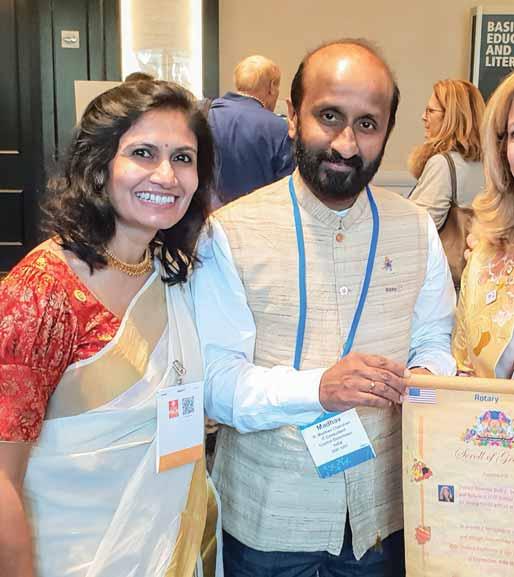
home and not thrown in the hotel rooms. So I decided that if the DGE’s name and picture are there on the gift, along with the names of the district and the projects done, there will be a better chance of it reaching home.”
It was decided that he would present a personalised ‘scroll of honour’ to each DGE whose district had done projects with Chandran’s district. This meant putting a picture of the DGE and his/her spouse on the scroll. This was easier said than done; “my district secretary Jojoe Jacob sat in my office for a whole
week as we searched for photos of the incoming governors and their spouses on Google,” he laughs. He was amazed to find that some of the districts, particularly in the US, had done between 10–14 projects with RID 320.
Finally came the much-awaited governors’ training programme in San Diego. DGE Madhav Chandran and spouse Sujata boarded the flight armed with 104 personalised scrolls of gratitude.
Recalls the DG: “The IA was indeed a memorable experience to be relished. The grandeur of the

He got from RISAO a virtual treasure trove of 313 projects worth $10.84 million, done by 104 districts worldwide, in partnership with his district.
Grand Ball Room, the imposing stage, the events that ran with clockwork precision; it was a melting pot of cultures, costumes and cuisines. But what made it even more special for us was connecting with the 100-odd DGEs.”
As the couple went around the task of locating the DGEs from districts which were trusted partners from the past and presented the scrolls, which not only reinforced past relationships but forged new ones, the scrolls created a buzz of their own! “There was astonishment at knowing about so many projects that had healed children, supported the elderly and provided healthcare, education and sanitation to a multitude of beneficiaries,” said Chandran, admitting that it was a “logistical nightmare to identify 104 faces in the nearly 2,000 delegates at IA ’19, but the results were magical.”
The DG adds that one DG from the US has already contacted him for doing a mobile eye clinic project worth $15,000.
RID 3201 DG Madhav Chandran hands over a scroll of gratitude to DG Beth E Troller. Also in the picture are their spouses Sujata and Rodney.
And then there is this invaluable bond of friendship. Recently, during Onam, “when I didn’t have much to do and decided to take a holiday with my family in Mauritius, I called up the DG I had honoured with one such scroll. He overwhelmed me by being at the airport with his DGE and DGN to receive us. I also visited his club and addressed its members.”
It was ideas galore as delegates from four districts gathered at a menstrual hygiene management (MHM) seminar hosted by RC Seven Hills Dharwad, RID 3170. Discussions ranged from why men should also understand menstruation and how they can help in making it easy for women, to how girls need not
stay tied to their homes just because they are menstruating. When a male delegate asked why this was referred to as “periods”, a woman delegate quipped: “This shows how we, at least in Rotary, have come a long way in discussing menstruation openly without inhibitions and are perfectly comfortable to discuss it here with
men. The silence needs to be broken everywhere.”
The meet focused on educating teachers to train students to handle menstruation sensibly and in a healthy manner. Teachers and students from government schools around Dharwad were present. The children were given Happy Kits, each
Schoolchildren get Happy Kits from PDG Ganesh Bhat and Dr Meenakshi Bharat in the presence of (from L) RC Seven Hills Dharwad Secretary Prashanti Reddy, Club President Gauri Tavargeri, Sandhya Masurkar, RID 3160 DG Nayan Patil, Shikha Patil, DGND Venkatesh Deshpande, Event Co-chairman Vani Irkal and Joint Secretary Pallavi Deshpande.

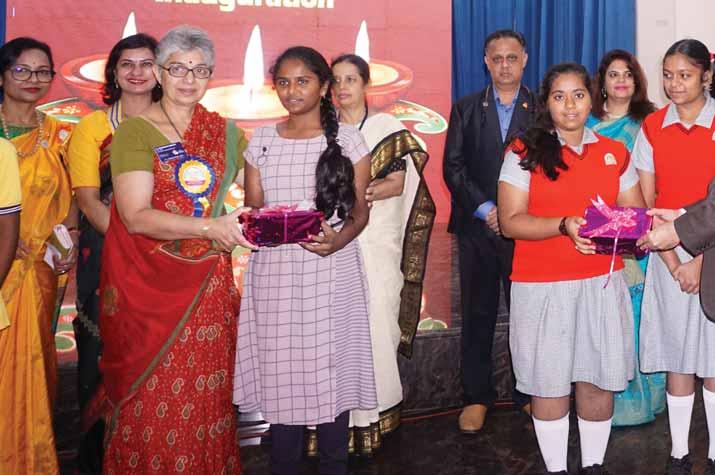
containing two cotton reusable sanitary pads, a bottle of handwash lotion, a soap and some chocolates. PDG Ganesh Bhat convened the event and Sandhya Masurkar, wife of DG Girish Masurkar inaugurated it. Host club president Gauri Tavargeri welcomed the delegates. DG Masurkar, DGND Venkatesh Deshpande and DG Nayan Patil (RID 3160) participated.
Menstruation has always been clouded in misconceptions that have been perpetuated over generations. Period taboos exist across the world, said Gauri. In Malawi, menstruating women cannot cook with salt, because it is believed their teeth may fall out! In our country they are not supposed to bathe or touch pickles on menstruating days, she added.
The stigma attached to menstruation continues to hold back commu-
nities in rural and backward areas everywhere. “This is only the tip of the iceberg. We must work towards managing menstrual hygiene so that no girl is held back at home because she is menstruating. And like how we initiated handwash and use of toilets at homes, girl children must be trained to be catalysts of change that they go back home and teach their mothers, relatives and neighbours to manage their periods safely and hygienically,” said Bhat, a member of Rotary India WinS Recognition Committee. He said MHM is part of WinS as it focuses on health and hygiene issues.
For a woman to manage her period hygienically and with dignity and confidence, she needs a support system “and who knows what she feels,” said Dr Meenakshi Bharat, a gynaecologist and member of RC
We, in Rotary, have come a long way in discussing menstruation openly without inhibitions and are perfectly comfortable to discuss it here with men.
Bangalore West, RID 3190. She advocated “sustainable menstruation” through reusable pads and a menstrual cup. “The pads we use now are not as harmless as they seem. They are toxic,” she said and discouraged clubs from promoting disposable sanitary napkin vending machines and incinerators. Reusable cotton pads last for 2–3 years. “These have no chemicals, are environment-friendly and cost `200. Imagine the good you will be doing to the environment, while also helping an underprivileged girl.”
Shweta Shurpali, who has a doctorate in environmental law, pointed out that rules should be drafted for their organised disposal, similar to disposal of bio-medical waste. “As of now, they are treated as solid waste and are hazardous to the environment.”
A panel discussion on best practices to create awareness among people generated interesting thoughts.

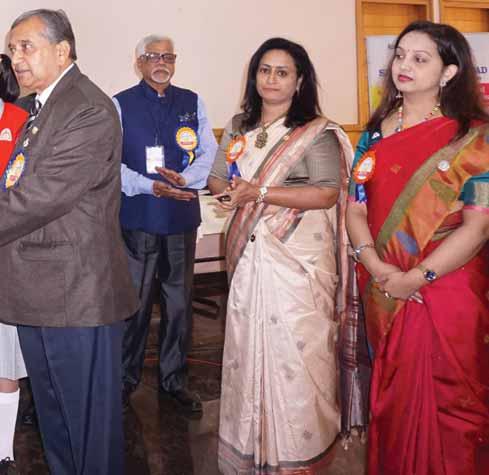
Dr Rajeswari Kulkarni, wife of PDG Anand Kulkarni, recalled how in 2017–18, she formed an Anns club with spouses of Rotarians as members. “We visited schools in the district and talked to teachers and adolescent girls about MHM, and convened a PTA meet in various schools to counsel parents with doctors’ support.” They would visit villages and educate women about proper use of sanitary napkins and their disposal. Older children in schools were trained to introduce the subject on menstrual
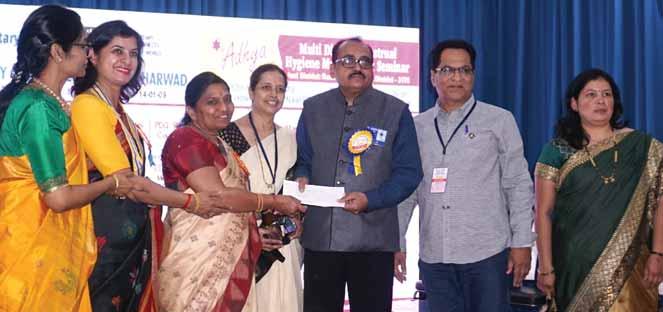
cycle and its management to their juniors on the threshold of puberty.
One teacher shared her experience on how involving fathers in PTA sessions about MHM has helped them understand the biological process better and enhanced the emotional bonding in the family. “Let’s stop whispering about periods and empower the men about it so that they understand the psychology of women and look at them them with respect,” added Dr Meenakshi.
Shikha Patil, wife of RID 3160 DG Nayan Patil, admitted that MHM was a new concept and the seminar had enlightened her to address the issue in various ways in her district, including the concept of menstrual cup as an effective way of managing periods.
The role of RCCs in educating the rural population was highlighted. “RCC members have better access and share a good rapport, especially with villagers. So their messages and suggestions are readily absorbed by the people. They, as also Rotaractors, make good ambassadors for the MHM
RCC members share a good rapport with villagers. They, as also Rotaractors, make good ambassadors for the MHM programme among women.
programme among women,” said Dr Geeta Kaushik, member, RID 3182.
Dr Pricilla Thomas, a gynaecologist, shed light on medicines that ease menstrual cramps. “Many people have their own reservations about taking these tablets even though I prescribe them. Myths such as it will cause infertility abound. Menstrual cramps need not stop girls from attending school,” she said.
The audience became interactive when a teacher mentioned a prevalent practice of postponing menstrual cycle with medicines during religious events. “Why is this practised in this age? Isn’t it time we accept the fact
that it is a biological process and need not interfere with religious practices,” she asked.
Utkarsha Patil, wife of DGE Sangram Patil, shared her experience as Inner Wheel Chair in spreading MHM awareness. Rotary should join hands with Inner Wheel to make an effective penetration among women everywhere, she said. Rotary can take corporate support for distributing reusable sanitary pads among women and girls which will ensure hygienic period management, suggested Dr Meenakshi.
Event Chair Renuka Salunke said several girls are staying away from school due to lack of awareness on menstruation and more such seminars will help spread the message. “We want to reach out to at least 10,000 girls,” she added.
The workshop was sponsored by Kishore Lulla, a member of RC Sangli, and he handed over cheque of `5 lakh for TRF to DG Masurkar at the event. Assistant Governor Sanjay Ingale proposed a vote of thanks.
Pictures by Jaishree

Interact President Dharaneedharan hands over the cheque for Polio Fund to PDG Chinnadurai Abdullah. PDG K Rajagopalan is also seen.
When IPDG Chinnadurai Abdullah appealed to the students of the Ramanathan Chettiar Municipal High School (RMHS) to contribute `1 to the Polio Fund, little did he realise that it will garner `96,000 on the occasion. Abdullah, as ARRFC, presided over the installation programme of the school’s new Interact Club. He announced that if the school, with a strength of 1,300 students can contribute `1,500, he will match it with a similar amount, and make the contribution to the Polio Fund in the name of the Interact Club. But to the surprise of the Rotarians, the Interactors brought in
`35,000. “Being a new club, we were enthusiastic with our first assignment. Chinnadurai Sir talked to us about polio and how Rotary had played a major role in making India polio-free. Inspired by his address, we formed two teams and visited all the classes. We talked to the students about polio and appealed for funds to help eradicate the disease globally.
Our friends contributed as much as they can and only when we counted what we collected we were surprised and happy with the huge amount and that too on our maiden venture,” says Dharaneedharan, a Class 9 student and President, Interact Club of RMHS which was sponsored by RC Karaikudi Pearl Sangamam, RID 3212.
The school headmaster Peter Raja, who is also the
Our friends contributed as much as they can and only when we counted what we collected we were surprised and happy with the huge amount and that too on our maiden venture.
Dharaneedharan President, Interact Club of RMHS
President of the parent Rotary club, along with another member P A G Muthukumar, inspired the Interactors with their contributions.
The story does not end here. When the Interactors handed over their collection to ARRFC Abdullah, the Rotarians rose up to the occasion and contributed their share, bringing the total to `48,000. Abdullah matched it, and `96,000 was contributed to TRF’s Polio Fund from this joint endeavour.
The enthused Interactors are now planning a greening drive on a big level and plant native saplings on the school campus and in their neighbourhood.
Rasheeda Bhagat
If sustainability is the crucial factor in getting an award, then one should go to the Rotaract Club of Akash, sponsored by RC Madras Fort, RI District 3232. One of the few Rotaract clubs in India with most of its 45 members being young professionals, the club was established 24 years ago, and for the 19th year in succession, it recently organised its most loved annual event in Chennai. Providing differently-abled — both physically and mentally — children a platform to showcase their talent.
On Oct 12, this year too, the Asan Memorial Senior Secondary School in Chennai was abuzz with activity, fun and excitement as it had about 600 young visitors from different schools for special children in the city. They were here to sing, dance, paint, perform all kinds of feats and acrobats... and generally let their hair down. When I get sketchy details but great pictures from the Rotaract club’s President Poornima Sundararaman about the




event titled Punnagai (smile in Tamil), I turn to the club’s Facebook page for more details. Here, two photographs and a video clip catch my attention.
One is a pookalam (floral design) done in vibrant colours such as red, yellow, green and orange titled ‘Save me’. It is an image of India that the child wants to
be saved; the other is titled ‘Save Nature, Save Earth’. The environmental concerns of the younger generation are amply demonstrated by these two images.
The video is of a teenager with an amputated leg performing the most amazing dance and acrobatic movements on the stage; his confidence and style takes your breath away!
Poornima, now in the US for personal reasons, says the club has 45 members, but only 30 are really active. Punnagai is an annual event in which the club’s Rotaractors get totally involved. Club Secretary Arjun S says that for this event, they get about 500 to 600 children from different schools in the city. For the whole day event, the children are “our responsibility. Right from picking up the kids from different schools, providing them with breakfast, lunch, followed by hightea and dropping them safely back to their schools is our task. While doing all this we have to ensure that the children never lose their smile!,” he says.
This is more a community-based rather than a college-based club, with most of the members working. While Poornima is a data analyst, Arjun works in a corporate. He says every year they organise this event in a grand manner and this year the cost was `4 lakh. “We raised the money through corporate sponsorship and donations from Rotarians,” says Arjun.
Poornima adds that this one-day cultural
show includes both the physically and mentally challenged children. “On this day, every year, we provide a platform to these children to let down their hair and enjoy themselves as they put up various performances in music, dance, painting, Rangoli/ kolam and a host of other activities in a creative and innovative fashion. It provides them an interschool platform to display their talent to the world, which boosts their morale and kindles their creative spirit,” she says.


What is even more striking than the fact that a Rotaract club has nurtured and sustained a single project for 19 years, is that they take care to invite prominent people from the world of art and culture, so that when they spot talent, they can give those children a much bigger platform and possibly a livelihood in the furture.
Adds Poornima, “We find this event so purposeful and enjoyable, both for us as well as the children, that we wish we could replicate Punnagai in other cities as well so that more special children get this platform.”
Really enthusiastic about community service, this Rotaract club is also conducting another event titled Sangamam , a RYLAlike programme for government school students to develop leadership qualities in them, and a sports tournament for rural children.
Designed by N Krishnamurthy
As Rotary Club of Guindy, RID 3232, celebrates its silver jubilee year, the members are excited about their project Sight Now, which was launched two years ago as a global grant project worth $87,500 to sponsor 900 cataract surgeries. RC Niles Fremont, RID 5170, US, and TRF are the international partners, and Sankara Nethralaya, the implementing hospital. Two vehicles, specially designed by IIT-Madras, are being used to treat people in rural and backward areas where medical facilities are lacking.
Nagammal (65) is a flower seller near Kanchipuram. For the last one year she was confined to her home as she had cataract in both eyes, and depended on her son’s family for everything. “When I was taken to this bus for treatment, I was very nervous. But now, thanks to these Rotarians, I am able to get back to work and am happy to take care of myself,” she smiles as her fingers deftly she smiles as her string jasmine flowers together.
About 120 surgeries were performed at Kanchipuram; and next in a village in Cuddalore district. “In Nagapattinam, we tied up with the local Rotary club,
RC Nagapattinam, RID 2981, for a 10-day eye camp. Their extensive PR activities brought in 1,000 patients,” says Club President R Sivaraman.
About 150 surgeries were done and 457 more are planned by the year end, he says.
Two buses — one for screening patients and the other with an in-built operation theatre — are driven to the camp site with doctors on board, says Kritika Madhukumar, the club’s PR Chair. The vehicles are equipped with RO plants, gensets, air conditioners and medical equipment.
Cataract is removed through suture-less laser treatment. “It costs about `30,000–40,000 for a surgery generally. But for Rotary it is at a subsidised charge of `5,750.” The project covers beneficiaries up to 600–700 km radius including parts of Andhra Pradesh and Karnataka. An ophthalmic team goes to the region one week later to do the follow up.

DGs G Chandramohan (RID 3232) and N Manimaran (RID 2981), congratulated the club members at the valedictory event.
The club has transformed a non-functional school into RC Guindy High School with support from Crompton Greaves. The vocational training centre established in 2009 provides classes in tailoring, doll making, beautician course and computer literacy for underprivileged women in the area.
The club has facilitated computer education, spoken English and Math for 30 academically-weak children of a government school. “We visit and teach them some life skills. A banker teaches them banking procedure. I teach them to sing. Recently we took them to a restaurant and taught them dining etiquettes. They enjoy the one hour they spend with us every week learning too,” smiles Kritika.
Sivaraman says that this kind of facility is available only in Chennai and Chhattisgarh, and villagers will lose daily wages if they need to travel. Hence they neglect their eyes.
Patients after cataract surgery; RC Guindy President R Sivaraman speaking at a camp site in the presence of RID 2981 DG N Manimaran (R) and RID 3232 DG G Chandramohan (second from R).


The Kottivakkam Centre for Acute Dental Care is another hallmark project of the club. Established in 1998 with a matching grant in association with RC Lorenskog, Norway, “over 20,000 patients have been treated here,” says Sivaraman. A dialysis unit and a health centre are the club’s other healthcare endeavours.
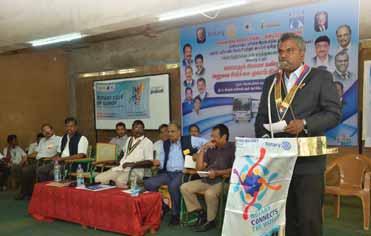
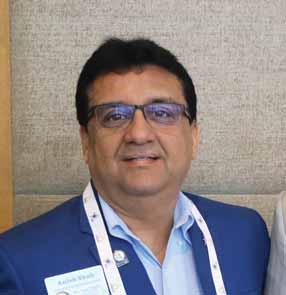
He is a second-generation Rotarian. His father, Pradyuman Shah, was a Rotarian for 40 years and mother Hansaben had served as District Inner Wheel Chair in 1987–88. “As an annet, I remember seeing a much younger PRIP Kalyan Banerjee in club meetings when I used to accompany my father in the ’80s,” says Anish Shah, adding that the entire college of governors was known to his father. “When he died in 2010, PRIP Banerjee (I call him uncle and Binotadi, aunty) came for the funeral. He was RIPE then. He would say that my father was his competitor as governor. Likewise, PRID Manoj Desai too is close to our family.”
It was his father’s ambition to serve as governor and Shah is happy to fulfill his dream.
He is excited about his district celebrating its golden jubilee and has lined up 5,000 service projects worth Rs 100 crore for the year. “We have executed 1,500 projects so far, benefitting at least 15 lakh people. We focus on maternal and childcare, WinS and literacy.”
He is confident of increasing his district membership which is now at 4,045, to 5,000 by the yearend. Clubs have inducted 600 new members but they have not been registered in My Rotary yet.
His target for TRF contribution is $1.5 million. “I am aiming at 100 per cent Rotarian-participation for contribution. Last year only 39 per cent Rotarians contributed to TRF. If every member can donate at least $25, which is a minimum cost of a family dinner, the district can top the records,” he says.
Swati, his wife, is a Rotarian of RC Valsad and hopes to lead the club soon.
Jaishree
Ranjeet Singh Saini
Electrical products, RC Raipur Royal, RID 3261
He joined Rotary in 1996. Ranjeet Singh Saini recalls how he has transformed from a green Rotarian not knowing his district number or club name to taking on the mantle as governor. It happened when he was on his honeymoon trip to Darjeeling. While he and his wife Rajjo were visiting a handicrafts shop, he saw the Four-Way Test poster stuck on the wall, and asked the shop owner if he was a Rotarian. The excited owner asked Saini about his club name and district number. “Until then I did not know about this concept of club or district name. All I knew was I was a Rotarian,” he laughs. Later the shop owner arranged for the couple’s trip to Gangtok.
Saini likes the ground level work that Rotarians are performing and “there are many backstage Rotarians who do not do things for fame or name. They do service projects because they empathise with people,” he says.
He is proud that his district has done very well in membership, adding almost 12 per cent new members. But he is concerned about the under-reporting
of members in some clubs. “There are members who are Rotarians for 10 years or even more, but they do not have a registration number. The best way to address this issue is that Rotarians must insist to get the registration number given by RI.”
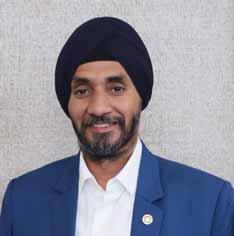
On TRF giving, the district’s target was $120,000 but “we have already raised $300,000 till now. My club alone has given $110,000 and $35,000 was raised during my installation,” he smiles.
His plans for the year include performing cataract surgeries worth Rs 4 crore and setting up an operation theatre worth Rs 2.9 crore at the Satya Sai Hospital in Raipur, both with global grants. Conducting RAHAT medical camps are also on his agenda. “We have completed one in Mandla that benefitted 100,000 people, two more are planned at Korba and Jabalpur before the yearend.”
He is a State-level badminton champion and his wife Rajjo is a member of RC Raipur Queens.
Electrical goods distributor, RC Kashi,
Youngsters must join Rotaract to experience how it enriches their lives. Mine has been shaped beautifully since my Interact and Rotaract days, and I am still learning as a Rotarian,” says Sanjay Agrawal enthusiastically. He was an Interactor in the 1970s and Rotaractor from 1982–88, before joining his Rotary club in 1989.
Agrawal is keen on promoting adult literacy and child development. “We are doing lot of work in setting up e-learning classrooms too,” he says.
He wants each member to introduce at least one person to Rotary and is “sure with 3,478
existing members, we can double the figures.” So is his strategy in raising funds for TRF: “I have asked each Rotarian to contribute $100.” He is happy to share that $130,000 was collected at the TRF seminar held recently in Varanasi.

His wife Poonam is a member of RC Varanasi Vrindha and a past Assistant Governor. She is encouraging spouses of Rotarians to join Rotary.
He has been to 16 RI Conventions and, along with his wife Sunita, served as assistant sergeant-at-arms in nine of them. Dhiran Datta is proud to say that his coat is adorned with 380 pins, testimony that he loves interacting with Rotarians world over.
“For me the inspiration to join Rotary came from home,” he says, having been encouraged to join Interact and then Rotaract by his Rotarian father before joining his club in 1991.
“I love the internationality of the organisation and the opportunities it provides to care for the needy.” He has been a GSE and GFE leader and has led an IYE team to Sri Lanka.
Datta opines that when Rotary’s public image is enhanced, Rotarians will be inspired to contribute generously to TRF. “The LN4 artificial limb camps conducted at Bhopal and Lucknow recently has elevated the mindset of our members. Around 320 people of the 358

registrants have benefitted from the camps. All of us are happy with this wonderful work and I am sure this feel-good attitude translates into giving to benefit a larger society.”
His target for TRF giving is $80,000 which, he says, is achievable, although “MP is a relatively poor State”. He is planning a 20 per cent growth in the district’s membership and proposes to add five new clubs and 10 Rotaract clubs. Three Rotary clubs have been chartered so far. Adding 40 new women members is also on his agenda.
He is excited about a mega music competition for schoolchildren that is being conducted in the district for five years now, this year being extra special as participants have registered from abroad too.
His wife Sunita is member of the same club.
Administration – Public Sector, RC Quilon, RID 3211
Shirish Kesavan is concerned about the rehabilitation of people affected by the 2018 floods that destroyed several parts of Kerala. “We are still constructing houses for those who had lost their homes then,” he says.
He wants to ensure zero waste in the district and has encouraged clubs to adopt and manage waste generated in the 200 municipal wards in the region by involving RCCs in large numbers. Construction of toilets under WinS programme is his other focus.
On membership
Kesavan is planning a 40 per cent increase as also increasing the number of Rotaract and Interact clubs. The district has only two Rotaract clubs.
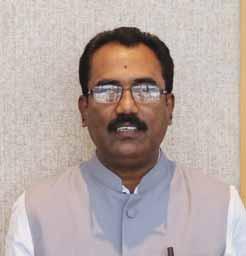
He aims to raise $10 million for the Foundation.
He is a Rotarian since 1996 and is thankful to the organisation for having given him several friends on an international level.

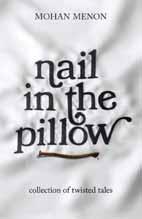
Author : Mohan Menon
Publisher : Notion Press
Pages : 200; `299
Shockand surprise are the riveting guns of this short story collection. While the sun is shining and the birds are singing, you are abducted and plunged into a journey through the shadowy, quirky side of human nature. Complacency goes out of the window as you are swept along helplessly.
Mohan Menon’s slim volume of short stories is a page-turner and comes with a caution ‘Do not Read After Dark’. All the 25 stories are relatable in terms of the scene and context in which they are set and have an unexpected twist in the end. Covered succinctly in 198 pages, these tales will leave you in a state of heightened surprise and uneasiness. Written in a simple style, the book is eminently readable.

Author : Eva Jarlsdotter
Publisher : Yellow Kite
Pages : 128; `399
Inseven simple steps this book will help you remove waste: wasted money, energy and resources give you the gift of time. The book lists a set of principles embraced by the most creative and dynamic organisations around the world, and for the first time, Swedish social entrepreneur Eva Jarlsdotter applies them to family life.
Embracing the Japanese ‘stream’ technique, the author shows you how to systematically create and maintain order. From kaizen (continuous improvement) to kanban (visual planning), these principles will bring harmony and a sense of flow to your home. No more time wasted searching for your keys, important paperwork or your internet banking password; no more throwing away food past its shelf life or arguing about the mess; no more feeling on the backfoot all the time. This transformative book will also empower children to take responsibility for their belongings and follow their schedules, thus lessening the burden on parents.

Pangat, a Feast: Food and Lore from Marathi Kitchen
Author : Saee
Koranne-Khandekar
Publisher : Hachette India
Pages : 360; `599
Bringing together over 200 traditional recipes, this enriching book introduces food enthusiasts to special masalas, cooking techniques and elaborate meal spreads using a range of produce. Its delightful stories and anecdotes vividly detail the characteristic food traits of the several communities that inhabit the region.
From the deeply-spiced Kolhapuri mutton sukka to the tamarind-based thecha, from a never-fail formula for frying fish to the wholesome chakolya ‘pasta’ and variants of karanji, the recipes in this book will at once enhance your culinary skills and palate.
In this delectable compendium of recipes and stories, culinary researcher Saee Koranne-Khandekar debunks the myths surrounding the foods of Maharashtra and reveals the versatility and sheer variety of its food traditions.
Endorsed by noted food writer Kunal Vijayakar and celebrated chef Ranveer Brar, the book is a treasure trove on the traditional recipes of the region.
Compiled by Kiran Zehra
Designed by Krishnapratheesh S
Yesterday, I tapped on the message What’s your hearing age? You may have received it too on your cellphone. You tap. A wailing sound comes on. You tap again when you stop hearing the sound. And up pops your hearing age. Mine said: 52. Since I’m 65, it brought a broad smile to my face. I may be a chump, but I’m sold.
Money cannot buy happiness, but apps can make you feel good. So can all the mushrooming workshops on abundance, mindfulness etc . People are so stressed, so lost, so miserable, they are willing to pay good money for a day of meditation, mind-changing affirmations, regressing to their past lives, opening their blocked chakras Often, they return to the process to top up their happiness or alleviate the unhappiness that has crept back in.
I’m grateful that so many techniques have sprung up along with, of course, traditional psychology and medicines. I always thought my mentor Reverend Normal Vincent Peale was the sole teacher of positive thinking

and now I’m delighted to hear about Dr Martin Seligman, a psychologist, who introduced the world to positive psychology 19 years ago. The good doctor believes happiness and studies on happiness are a field in themselves and should not be tagged to psychology. Happiness is about well-being, contentment, even a sense of flourishing. On a day-to-day basis, there should be an ease to living. While psychology is about pills and re-setting cognition and so on, positive psychology has a broader vision. It encourages acceptance of the past, optimism about one’s future and being anchored in well-being in the present. Dr Seligman spells it out: “It’s about education, work, marriage — it’s even about sports. I want to see psychologists working to help people build strengths in all these domains.”
Feel strong. More than being strong, feeling strong is what gets us through. Strength isn’t one big thing, it’s a million little things — the ability to make your ego porous or small, being

uncomplaining when the going is not good and not being arrogant when the going is good, openness, patience, receptivity, letting go the need to defend your point of view, allowing your experiences to make you wiser… sometimes, the world mirrors your defects and weaknesses. These don’t get you down if you have a cheering team, for example, family and friends who encourage you and often point out your strengths and your positive qualities at appropriate times. And if you are in the habit of appreciating all the things that go right every day, you keep adding to your happiness quotient (HQ).

As you add to your HQ, you need to subtract the nonsense from your mind. A lovely little teaching tale goes: The Master gave a newbie two boxes, saying, “Put all your expectations in the black box. And all your joys in the gold box.” The newbie followed the instructions faithfully. Interestingly, he found the gold box becoming heavier while the black remained light. Curious to know why, he opened

Bharat and Shalan Savur

the black box and saw a hole in the bottom through which his expectations had slipped out. He asked the Master about it. The Master replied, “My child, the gold is to enable you to count your blessings, the black is to enable you to let go.”
There’s a wonderful teaching here: Our expectations lead us to helplessness and frustration. It’s like sticking our finger in a fire and wondering why it burns and hurts. Our thoughts and creativity get trapped in the mesh of expectations. Our happiness and satisfaction at doing something are robbed by our expectations. That’s why the wise Master didn’t tell the newbie to put his sorrows in the black box, he specified expectations. My wise father taught me, “When you keep one eye on your work and the other on the reward you hope to get, your work suffers. And when you keep both eyes on your


work, you achieve excellence.” It’s a direction I’ve never looked away from.
This article is about keeping ourselves in the zone of happiness day after day. On a scale of 10, sometimes, it may be 7, sometimes 2… It’s okay. You don’t have to score 10 every time. At times, you may not be so happy, but at peace — that’s good too. When you learn, you raise your maturity. When you get the way the world works, there is a flash of understanding followed by a settled kind of happiness and serenity that are not easily shaken.
The way is to keep working and creating a life that feels good externally, but, at the same time, never neglect to create a life that feels good and comfortable internally. Do little things that ease day-to-day living. Talk in such a kind way that your breath will never want to leave you, walk with such an easy stride that all your body parts will revel in their strength and flexibility, live in such a simple and adaptable way that peace and positive vibrations dominate your temperament. In this spirit, I present some wise and wonderful ways to live life by: Bring closure to grief, grouses, grudges.
Do away with unnecessary rituals and routines that don’t leave you singing. Clarity in the mind is a blessing.
If you have doubts about something for three days, it is not for you. When you are on the right track meant for you, nothing can hold you back.
Rather than blame somebody, decide to bloom on your own. Master that which you are interested in. Learning is a wonderfully absorbing state of living.
When somebody sulks and keeps a radio silence, turn your attention to exalted ideas and radiate silent blessings all around. It’s the only way.
Don’t look on everything in life as a challenge, but as a time to be creative. Creativity is balm to the brain, an inner light in which the mind can stroll peacefully.
Eat foods that suit your body. Don’t let food eat away your health. Foods that make your head throb or spin, have your skin break out in a rash, that make you heavy, acidic, uneasy are best avoided. Keep your insides nourished and light with healing foods eaten in moderate quantities.
When there are too many demands on you, forget your own inner callings on such days to avoid the stress of resistance and ensuing emotions of anger and resentment. Look on all tasks whether chosen by you or by others for you as done for the Divine. They are. Decide to be patient endlessly. It ends anxious waiting.
Judging others is like parking your vehicle in another’s slot. All judgments are misplaced. What is ultimately towed away is your own peace of mind and health. Don’t argue. An argument is a war. The battlefield is the mind. Somebody shoots you, don’t shoot back. Put a check on your vanity, arrogance and me-ness; allow your higher instincts to pour through the conduit of your being.
Positive psychology lifts us from wellness to well-being. And Dr Martin Seligman says, “I believe it is within our capacity that by the year 2051, 51 per cent of the human population will be flourishing.” I sincerely believe it will be sooner than that.
The writers are authors of Fitness for Life and Simply Spiritual – You Are Naturally Divine and teachers of the Fitness for Life programme.
Designed by N Krishnamurthy



Sandhya Rao

learn a lot from those, including the reviewer’s personal preferences because the choices you make are so subjective. Of course, there are also a whole lot of books that recommend themselves because they’re just amazing and no amount of subjectivity will camouflage that. But certainly, book reviews are one clue.
A little aggression on this account wouldn’t be a bad thing.
Oh, I don’t read.” Like, it’s a waste of time. Like, it’s the in thing. Like, bro, who does that!
The frequency and nonchalance with which I’ve heard this statement being tossed about over the last few years should have finished me off but for the overriding optimism that rides over that sinking feeling. Still, it’s not funny when one young person after another prefaces a discussion on books or even college/ school book-based assignments with words that suggest next to no reading of anything except textbooks and, if ever, some motivational material. Believe me, it takes a lot of will power not to let fly a left or right hook! If I were a boxer, that is. But that’s how deep it gets under my skin when I think of all the people who are not reading these amazing books desperately calling out to be picked up.


So, yes, even a hardened optimist such as myself gets depressed. The

good thing, though, is that if you love to read, you can’t stay depressed too long because you know there’s always a good book waiting around the corner. It’s merely a question of finding it.
Some people ask: How do you know you want to read a particular book? The simple answer is: I don’t. It’s the detective inside that unearths or stumbles upon the clues. The most obvious are book reviews. You can
Then there’s promotional material put out by the publishers. However, be warned. This is all to do with selling the book so don’t be fooled. What such material is good for is a gist of the content or maybe sometimes, even a short extract. Read and judge for yourself. There have been instances of the promos outdoing the product, meaning the marketing of the book is far superior to the stuff between the covers. Now, I will name no names for fear of reprisal, but there’s been a sharp rise in these figures lately, definitely in India, shall we say? And this has been seen to be reflected in sales figures. Still, what matters is that it leads to books being read — or bought, at any rate!
Sometimes, the clue comes from the book itself. Glance through the first few pages. Does the writing hold your interest? Sometimes the first line can do it. But for this, you will need to look inside the book. Then again, I know they say we should never judge a book by its cover but on occasion, this too can provide a clue. Not always, though

If you love to read, you can’t stay depressed too long because you know there’s always a good book waiting around the corner. It’s merely a question of finding it.


because, you said it: Don’t always judge a book by its cover!
Bookshops always display books upfront. These are by way of ‘recommendations’, although very often they are a reflection of how well the publisher or distributor has managed to push their books. In some bookstores I’ve seen shelves displaying what they call ‘staff recommendations’, that is, books enjoyed by people working in the store itself. Libraries also tend to do this, but that’s mostly fair and square and often depends on theme. For instance, November may be dedicated to showcasing children’s books because November 14 is Children’s Day; or October could be books on and/or by Mahatma Gandhi for obvious reasons; December could be all about the Christmas spirit or, in the current context, Ayodhya, the Babri Masjid and Ram Lulla. Whatever the reason or the MO (modus operandi — we’re playing detective, remember?), the end result is the same: trying to find good books to read.


However, the best MO is word of mouth. Someone, often a friend, tells you about a book she has read and suggests you do too. Or, if your friend is like yours truly, she thrusts the book upon you. This happened once. I forced Amitav Ghosh’s The Glass Palace on a dear schoolfriend who was generally not much inclined to read. Initially he was all enthusiasm but as days grew into

weeks, the pressure grew too. From wanting to develop an interest in reading, he began to feel he had no choice but to read and that transformed into relentless guilt. Finally, when the weeks had turned into months, the book became the elephant in the room each time we met and when, eventually he returned it, he did so without having turned a single page! “I was so afraid I’d lose it!” was his excuse.


This is what appeared on another website: it helps you discover yourself; it imparts valuable experiences from years of experiences; it improves your emotional health; it’s a great source of motivation; it expands your knowledge and makes you smarter; it enhances your creativity; it makes you more empathetic; it enhances critical and analytical thinking; it gives joy and pleasure; it makes you humble; it improves language and communication skills; it improves brain functions; you will never be alone; it makes you grow as a person.

Incidentally, Ghosh is among my favourite authors and so, on long distance, I trust that if you haven’t already read him, you will pick up his books — and turn the pages!
I read because I love to read. That’s a personal preference. On what basis should I recommend it to others? I checked out the internet for help on this matter. There are several sites that talk about the importance of reading. I picked one out at random. This is what it listed as the benefits of reading: it sharpens your mind; it increases your vocabulary; it lowers your stress; it decreases your depression; it improves your memory and focus; it enhances your imagination; it boosts your sleep; it entertains and brings peace; it brightens your day. Compelling reasons, all.
Before signing off, here’s a taste of Amitav Ghosh from The Shadow Lines about another subject close to my heart, photographs: “There is something strikingly different about the quality of photographs of that time. It has nothing to do with age or colour, or the feel of paper. … In modern family photographs the camera pretends to circulate like a friend, clicking its shutters at those moments when its subjects have disarranged themselves to present to it those postures which they would like to think of as informal. But in pictures of that time, the camera is still a public and alien eye, faced with which people feel bound either to challenge the intrusion by striking postures of defiant hilarity, or else to compose their faces, and straighten their shoulders, not always formally, but usually with just that hint of stiffness which suggests a public face.”

Most of us have photographs of that time and many of us take pictures constantly: we understand exactly what he means. I rest my case.
The columnist is a children’s writer and senior journalist.

Designed by Krishnapratheesh S

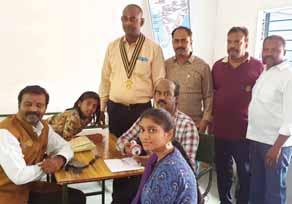
Madurai
Athree-day Rotaract RYLA was led by Event Chairman T Malaiarasan. Around 60 participants took part in the interactive sessions at the Pegasus Institute of Excellence in Pondicherry. PDG R Shanmugasundaram inaugurated the event, while DG Zameer Pasha gave the valedictory address.

RC Gurgaon Cosmopolitan — RID 3011
The club installed a library in a primary school at Nathupur village. Around 135 children will benefit from the facility.
AnENT camp was organised at a government school in Periapudur village in which over 120 people were screened for ailments. This was followed by distribution of hearing aids to over 80 patients at the Rotary Hall in Salem. The camp was held with support from the local RCC.
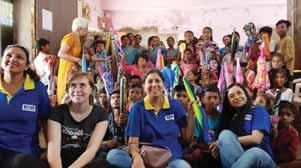
Under a micro credit programme, 15 women at Dongargaon village were given `20,000 each. The club is running this project through Niramay BahuUddeshiya Seva Sanstha to help women to start their own business.

Adental camp was held at a government school, Nepania, in which over 350 children were examined for oral hygiene. A panel of doctors from the government dental college advised children on keeping their teeth clean and healthy.
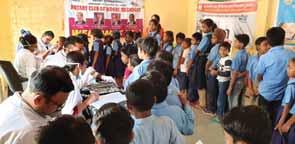
Atalk on self-hygiene was held at the Pratap Public School, Jundla, for adolescent girls. A new interact club was installed at this school. The club gifted floor mats for students to sit on at the MDD Bal Bhawan Anath Ashram.
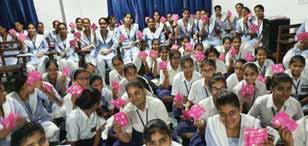


DG Sanjay Agrawal inaugurated a Rotary Chowk (roundtana) sporting the Rotary Wheel and a green hub at the city airport as part of its public image project. The installations with the Rotary insignia will enhance the club’s profile in the community.

The club, in association with Robin Hood Army, a local NGO, organised a food donation drive. Around 10,000 kg of provisions, mosquito coils and LED bulbs were distributed to 30 tribal villages in Pen taluk. More than 1,000 tribal families benefitted from this project.
density check-up camp, led by Project Chairman Vaneet Garg, was organised at the Prime Hospital with Rtn Dr Romit Gupta and his team screening over 120 patients.
Aschool for tribal children was adopted at Samba village in Palgarh district. Rotarians encouraged students to plant trees on the campus, save water and avoid use of plastic products. Cloth bags were also distributed.

RC Dombivli Industrial Area — RID 3142
Umbrellas were distributed to 25 postmen at the Tilak Nagar Post Office as a goodwill gesture. The project was sponsored by District Secretary Prakash Shah.
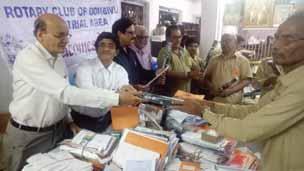
RC Guntakal — RID 3160
The club joined hands with Rotaractors and Inner Wheel members to conduct a seed ball preparation camp at the estate of Rtn Thimmaraju for planting saplings.


The club felicitated conservancy workers for their dedicated efforts in maintaining cleanliness in the region. E-waste bins were donated to the civic body to collect electronic scrap hazardous to the environment.
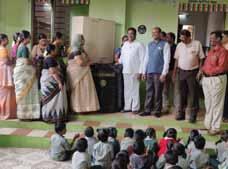
The club donated a large water storage tank and cupboard to a school. The students were happy as they will not experience water scarcity in school.

Atree plantation project was taken up in the neighbourhood, mostly in schools. The club also supplied 500 saplings to the public and school authorities to usher in a green environment.
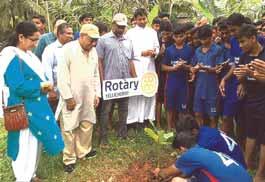
As part of centennial celebrations of Rotary in India, the club provided essential items such as food, medicines and bedsheets to Anpakam, an old-age home which also sheltered mentally-challenged people. A medical camp was organised there.
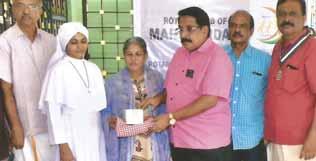

An awareness drive against single-use plastic was held at Mahabalipuram near Chennai. Rotarians distributed leaflets to public to explain the harmful effects of plastic pollution.

TheInteract clubs at the Vana Vani Matric HS School and the Hindu Senior Secondary School did fundraisers worth over `25,000 for the $2 for two polio drops project. The amount was handed over to Club President Suryabaskar at a joint meeting.

The club sponsored 200 shelter kits for flood victims in the villages of North Lakhimpur district. The shelter kits cost `12 lakh and each kit has nearly 50 items to rehabilitate a family of four persons.
by V Muthukumaran
Designed by L Gunasekaran
You can pay the Rotary News / Rotary Samachar subscription online
Our Bank details:
Bank : HDFC Bank SB Account
Branch : Montieth Road Egmore, Chennai
A/c Name : Rotary News Trust
A/c No. : 50100213133460
IFSC Code : HDFC0003820
E mail us following details:
Name of Club
President/Secretary’s name
Amount/Date of transfer/UTR Number
For physical payment by cheque or cash in bank, write Club Name only without prefixing “Rotary club of”. Eg. Rotary Club of Delhi Central should be written: Delhi Central.
:
Please note Interact clubs that have not reported Interact Adviser in the past two Rotary years, are placed in “Suspended” status effective Oct 1, 2019. They will have until Dec 31, 2019 to report an Interact club adviser online or the Interact club will be automatically “Terminated”.
What defines a super power? Experts have suggested many definitions — money, muscle, culture etc — but I have just one criterion: what time does your plane take off on an international flight from India. By this definition, India is far, far away from being even a simple power, let alone a super one. The reason, and I am not joking, is that 94 per cent of the international flights that leave Indian airports do so between 10 pm and 3 am. This means you fly mostly through darkness in a dimly-lit cabin where everyone is digesting their dinner — and when dawn comes you have to use dirty toilets. God forbid that you have a dodgy tummy or even worse, the dreaded IBS.
Most international flights leave India between 10 pm and 3 am. You fly mostly through darkness in a dimlylit cabin where everyone is digesting their dinner — and when dawn comes you have to use dirty toilets.
Soon after you board at, say, 2 am, they serve you alcohol and a meal because that’s what the international civil aviation rules say. It’s nearly 3 am and you are dropping off to sleep after the long-drawn hassle of check-in, immigration and security when some equally hard-pressed member of the cabin crew wakes you up with a fake smile and a low-pitched growl: anything to eat or drink, Sir? It takes you another half-an-hour to nod off. You just sit there in utter misery till then. There is a final indignity to come. Three hours after serving alcohol and a horrible roll, they serve a full breakfast at 6 am. You tell yourself, if there’s hell on earth this must be it. It doesn’t matter where in the plane you are sitting — economy, premium economy, business or even first class. It’s all the same. Sheer misery if you have to fly between midnight and 8 am.
I love daytime flights because the cabin is not dark, the toilets are clean, you can enjoy your drinks and your meal and the movies and the short nap before the plane starts it’s descent. They serve tea and coffee and a snack, and it’s all very civilised. You land when the sun is still up, not rising, and you reach your hotel or home in time for a hot shower and a drink and nice dinner followed by a good night’s sleep. That’s what almost all the passengers in the western countries enjoy when they take an international flight.

However, it’s not as if other countries don’t have such night flights. In the US they call them red-eye flights because you land with that awful burning sensation in your eyes, which are red because of lack of sleep. And guess what. They all seem to be coming to India, from almost anywhere in the world. You fly overnight to London and then overnight from there to India. As I said, hell on earth.
The truth is that other countries are tough about this. They minimise the flights that inconvenience their citizens. But we are weak when it comes to this. We don’t insist that our airports will shut between 11 pm and 5 am. No takeoffs, no landings. Take it or leave it. We don’t say our airlines will fly at decent times that suit our citizens, not yours. Until that happens, India will remain, in my eyes at least, a minor power.
Many years ago, I asked the minister for civil aviation why this should be so. Are Indians third-class citizens of the world? His reply stunned me. Look at it this way, he said. You save the cost of one night in a hotel plus you get almost the entire day after you reach to work. I asked him if India thought the rest of the world was stupid to have not thought of this. He said yes, we Indians are very clever.
If you have heard of worse nonsense than this, please let me know.
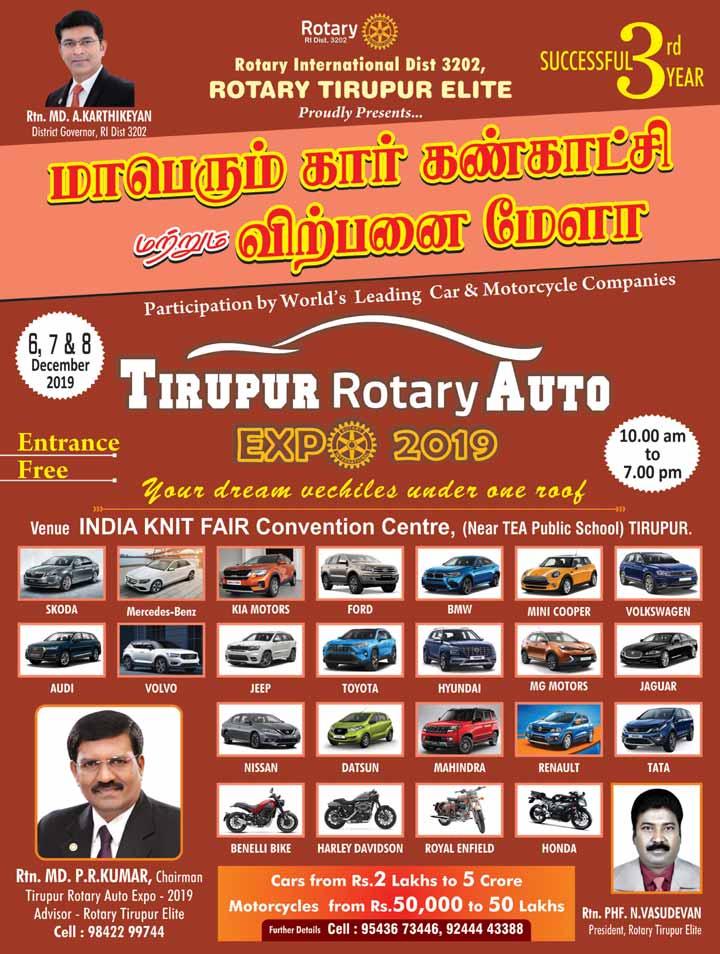
...these delicacies await you at the Zone Institute city





Regn. No. TN/CCN/360/2018-2020
Licensed to post WPP No.TN/PMG(CCR)/WPP-431/2018-2020
Total number of pages in this monthly issue, including cover, 84. Price: `35
Registered with Registrar of News Papers for India 3880/57 Rotary News Published on 1st of every month












